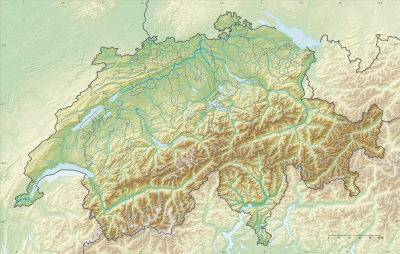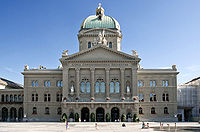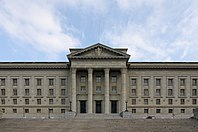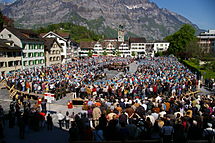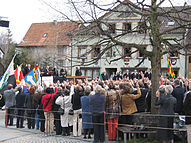Switzerland
![]()
This article deals with the state. For the landscape name, see Switzerland (landscape name).
Switzerland (French Suisse [sɥis(ə)], Italian Svizzera [ˈzvitːsera], Rhaeto-Romanic![]() [ˈʒviːtsrɐ] or [ˈʒviːtsʁɐ], Latin Helvetia), officially Swiss Confederation (French Confédération suisse, Italian Confederazione Svizzera, Rhaeto-Romanic
[ˈʒviːtsrɐ] or [ˈʒviːtsʁɐ], Latin Helvetia), officially Swiss Confederation (French Confédération suisse, Italian Confederazione Svizzera, Rhaeto-Romanic ![]() , Latin Confoederatio Helvetica), is a federal democratic state in Central Europe. It borders Germany to the north, Austria and Liechtenstein to the east, Italy to the south, and France to the west.
, Latin Confoederatio Helvetica), is a federal democratic state in Central Europe. It borders Germany to the north, Austria and Liechtenstein to the east, Italy to the south, and France to the west.
Switzerland is home to 8.6 million people. This makes the country one of the more densely populated states in Europe, with the population concentrated in the Central Plateau, the basin zone between the Jura and the Alps, and in southern Ticino. The eight largest cities or economic centers are Zurich, Geneva, Basel, Bern, Lausanne, Winterthur, Lucerne and St. Gallen.
The country shares three major language areas: the German-speaking one in German-speaking Switzerland, the French-speaking one in French-speaking Switzerland (Suisse romande, Westschweiz, Welschschweiz) and the Italian-speaking one in Italian-speaking Switzerland; Rhaeto-Romanic is added as a fourth language area (in parts of the canton of Graubünden). The four languages mentioned are the official languages of the Confederation. In order not to favor any single one, the country code is "CH", the abbreviation of the Latin term Confoederatio Helvetica.
The Swiss Confederation is a federal state consisting of 26 partly sovereign cantons. The seat of government and parliament is the federal city of Bern. Switzerland is considered a nation of wills; national identity and cohesion are not based on a common language, ethnic origin or religion, but on intercultural factors such as a belief in direct democracy, a high degree of local and regional autonomy, and a strong culture of compromise in political decision-making. Moreover, permanent neutrality is fundamental to the self-image.
The Swiss Confederation emerged from the so-called original cantons of Uri, Schwyz and Unterwalden. The unofficial and mythologized founding document is the Bundesbrief of 1291, the oldest surviving alliance document. The Peace of Westphalia of 1648 recognized their independence under constitutional law. Today's federal state has existed since 1848. The name Switzerland comes from the original canton of Schwyz or its capital of the same name.
On the Human Development Index, Switzerland ranked second in 2019, making it one of the very highly developed countries. Although it ranks 133rd in terms of country size and 98th in terms of population, it holds the 20th position among the largest economies in the world.
Geography
→ Main article: Geography of Switzerland
|
|
Landlocked Switzerland is located between the 46th and 48th parallel and has the headwaters of rivers that flow into the North Sea, Mediterranean Sea and Black Sea. The maximum north-south extension is 220.1 kilometers (from Bargen to Chiasso), the largest west-east extension is 348.4 kilometers (from Chancy to Val Müstair).
The highest point in Switzerland is the 4634-meter-high Dufourspitze on the border with Italy, and the lowest point is the shore of Lake Maggiore at 193 meters above sea level. also on the Italian border. The highest settlement, Juf, in the canton of Grisons is at 2126 m above sea level; the lowest settlements around Lake Maggiore in the canton of Ticino are at 196 m above sea level. The geographical center of Switzerland is in the canton of Obwalden on the Älggi-Alp.
Switzerland has a national border with a total length of 1935 kilometers. The longest national border is with Italy in the south, at 782 kilometers (→ border between Italy and Switzerland). In the west, Switzerland borders France for 585 kilometers (→ border between France and Switzerland); in the north, it borders Germany for 347 kilometers, most of which runs along the Rhine (→ border between Germany and Switzerland). To the east, Switzerland borders Austria for 180 kilometers (→ border between Austria and Switzerland) and the Principality of Liechtenstein for 41 kilometers (→ border between Liechtenstein and Switzerland).
23.9 percent of Switzerland's land area is agricultural land, 13 percent is alpine land. Settlement areas account for 6.8 percent, and 25.5 percent - mainly in the Alps and the Jura - is considered unproductive natural area. Around 30.8 percent is forest and woodland.
Natural classification
Switzerland can be divided into three large landscape areas that show great differences: the Jura, the densely populated Central Plateau and the Alps with the Pre-Alps. Around 48 percent of the country's surface area belongs to the Alps in the narrower sense, 12 percent to the Pre-Alps. Thirty percent are counted as part of the Central Plateau, and the Jura occupies the remaining ten percent of the country's area.
The Swiss Plateau is geographically and geologically delimited in the northwest and north by the elongated mountain ranges of the Jura. In the south towards the Alps, the relatively abrupt rise to heights above 1500 m above sea level in some places is usually used as a criterion for demarcation. The southwestern boundary of the Swiss Plateau is formed by Lake Geneva, the northeastern by Lake Constance together with the Rhine. The population density of Switzerland is determined by the urban centers, all located on the Central Plateau, with the two world cities of Zurich and Geneva, modest in size but nevertheless important.
In Switzerland, the term Pre-Alps refers to those areas that mark the transition from the slightly hilly Swiss Plateau to the mountainous area of the Alps and are characterized by their elevations as a local recreation zone especially during periods of high fog. With the Alps, they describe an arc between the southwest and northeast of Switzerland.
The Alps form an important climate and water divide in the "heart of Europe" with additional alpine and intra-alpine weather effects, due to which Switzerland usually has several weather conditions despite its small size. The Swiss Alpine arc is home to well-known vacation destinations for summer and winter tourism as well as the only Swiss national park. The network of public transport in Switzerland, which is also present in the Alps, received a UNESCO World Heritage Site in the form of the Albula line, which complements the natural heritage of the mountain landscapes Tectonic Arena Sardona and Swiss Alps Jungfrau-Aletsch.
The south side of the Alps is a term used mainly in weather forecasts, since weather conditions, climate and vegetation usually differ from those on the north side of the Alps. The southern side of the Alps includes the canton of Ticino, the southern valleys of Misox, Calanca, Bergell, Puschlav and Val Müstair in Graubünden, and the area south of the Simplon Pass in the canton of Valais, and belongs to the Alps in natural terms.
The Swiss Jura can be roughly delimited in the east and southeast by the Swiss Plateau, in the north by the High Rhine, in the northwest by the Burgundian Gate. The Jura is a geologically young folded mountain range with a longitudinal extension of about 300 kilometers and describes a large crescent-shaped arc open to the southeast. On the Besançon-Yverdon line, the greatest width of the mountain range is about 70 kilometers. At Biel/Bienne, the chains change direction more and more to the east, the mountain system becomes narrower, and the number of adjacent chains decreases. The easternmost Jura chain, the Lägern chain, runs in an exact west-east direction and ends at Dielsdorf, where the mountain-forming strata dip below the molasse of the Swiss Plateau.
See also: List of regions in Switzerland
Geology
The geological structure of Switzerland is essentially the result of a plate collision of Africa and Europe during the last millions of years. This phenomenon is particularly visible in the Glarus Main Thrust, a UNESCO World Heritage Site.
Geologically, Switzerland is divided into five main regions: The core of the Alps (→ Geology of the Alps) consists of granite, while the Jura (→ Geology of the Jura) is a young folded mountain range of limestone. Between the Jura and the Alps lies the partly flat, partly hilly Central Plateau (→ Geology of the Central Plateau). In addition, there is the Po Valley in the southernmost tip of Ticino, the Mendrisiotto (Mendrisio), and the Upper Rhine Plain around Basel, most of which lies outside Switzerland.
During the last two million years, the topography of today's Switzerland was decisively shaped and formed by the huge ice masses that had advanced far into the Central Plateau during the various ice ages.
Compared to other European countries, Switzerland has a medium earthquake risk, although there are regional differences: Earthquakes occur more frequently in the Valais, Basel, the St. Gallen Rhine Valley, central Grisons, the Engadine and central Switzerland than in other areas. An earthquake of magnitude 6 or greater can be expected every 60 to 100 years. The last time an earthquake of this magnitude occurred was in 1946 near Sierre in the Valais. The earthquake that occurred near Basel on October 18, 1356, is the strongest documented in Central Europe in historical times. The Swiss Seismological Service (SED) at ETH Zurich monitors earthquake activity in Switzerland as well as in other countries close to the border.
See also: List of earthquakes in Switzerland
Mountains
There are over 3350 peaks above 2000 meters in Switzerland. The sixteen highest peaks in Switzerland are all in the Valais Alps. The highest peak is the 4634-meter-high Dufourspitze in the Monte Rosa massif, which is the most powerful mountain massif in the Alps. Thus, the Dufourspitze is also the highest point in Switzerland. The highest mountain lying entirely on Swiss territory is Dom. It belongs to the Mischabel group and is 4545 meters above sea level.
Probably the most famous mountain in the Swiss Alps is the 4478 m high Matterhorn. In the Bernese Oberland, the Eiger (3967 m a.s.l. ), the Mönch (4107 m a.s.l. ) and the Jungfrau (4158 m a.s.l. ) form a well-known group that is also visible from the Central Plateau. Prominent points of the Eastern Alps are Piz Bernina (4049 m a.s.l. ), the easternmost four-thousand-meter peak in the Alps and the only four-thousand-meter peak in the Eastern Alps, and Piz Kesch, another mountain with more than 1,500 meters of prominence.
In the foothills of the Alps, the elevations are lower, but the mountains are no less imposing due to their dominance and embrasure height. Well-known mountains are the Lucerne local mountain Pilatus (2132 m above sea level), the Mythen (1898 m above sea level), the Rigi (1797 m above sea level) in the canton of Schwyz or the Säntis (2502 m above sea level) in the Alpstein in eastern Switzerland.
The highest Swiss Jura mountain is Mont Tendre at 1679 m a.s.l. Other important mountains are La Dôle (1677 m a.s.l. ), Chasseral (1607 m a.s.l. ), Chasseron (1607 m a.s.l. ) and Suchet (1588 m a.s.l. ). The easternmost foothill of the Jura is the Randen in the canton of Schaffhausen.
See also: List of mountains in Switzerland and List of valleys in Switzerland
Glacier
The Swiss high mountains are dominated by the many glaciers. The largest and longest Alpine glacier is the Great Aletsch Glacier, followed by the Gorner Glacier (by area). Swiss glaciers reached their last peak during the Little Ice Age, which lasted from the beginning of the 15th to the middle of the 19th century. Since the middle of the 19th century, Switzerland, like almost all over the world, has experienced a significant retreat of its glaciers. This glacier retreat has intensified in recent decades. Between 1973 and 2010, the area of all glaciers in the Swiss Alps decreased by 28 percent to about 940 square kilometers. In the heatwave summer of 2015, the glaciers lost many times their mass compared to previous years.
See also: List of Swiss glaciers
Caves
The Hölloch in the canton of Schwyz is the second longest cave system in Europe and the Lac Souterrain de Saint-Léonard in the canton of Valais is the largest natural underground lake in Europe.
See also: List of caves in Europe (section Switzerland)
Waters and islands
→ Main article: Hydrography of Switzerland
In water-rich Switzerland, two of the longest rivers in Europe, the Rhine and the Rhone, have their source in the Gotthard massif. Several major European watersheds run through Switzerland: They separate the catchment areas of the North Sea, the Mediterranean Sea and the Black Sea. Thus, the Rhine and its tributaries flow into the North Sea, the Rhone and the Ticino into the Mediterranean, while the waters of the Inn reach the Black Sea via the Danube. A triple main watershed is found on the Lunghin Pass.
Within Switzerland, the Rhine has the longest course with 375 kilometers, ahead of the Rhine tributary Aare with 295 kilometers. The Rhone flows 264 kilometers within Switzerland, while the Reuss, the fourth largest river in Switzerland, reaches 158 kilometers in length. Other defining rivers are the Saane in the west, the Ticino in the south, the Birs and the Doubs in the northwest, the Linth/Limmat and the Thur in the northeast and the Inn in the southeast. Near Schaffhausen, the Rhine forms the largest waterfall in Central Europe (Rhine Falls). At times, there was an idea to connect the North Sea and the Mediterranean with a waterway by means of a trans-Helvetian canal between the Rhine and the Rhone, but this project was never realized.
Due to its topographical structure and especially due to glaciation during the ice ages, Switzerland has about 1,500 lakes, a large part of which are smaller mountain lakes. In total, about four percent of Switzerland's surface is covered by lakes, but this total is mainly determined by Switzerland's largest lakes: The largest lake in Switzerland is Lake Geneva (580.03 square kilometers) on the French border. Almost 60 percent of it lies on Swiss soil. Lake Constance, which borders Germany and Austria, is somewhat smaller at 536.00 square kilometers (23.73 percent of the shore length on Swiss soil). Lake Maggiore on the Italian border (19.28 percent on Swiss territory) forms the lowest point in Switzerland at 193 meters above sea level. The largest lakes lying entirely within Switzerland are Lake Neuchâtel (215.20 square kilometers), Lake Lucerne (113.72 square kilometers) and Lake Zurich (88.17 square kilometers).
There are numerous larger and smaller islands in the Swiss lakes and rivers. Among the best known are the Isole di Brissago, St. Peter's Island and Ufenau.
See also: List of lakes in Switzerland, List of rivers in Switzerland and List of Swiss islands
Climate
North of the Alps there is a temperate Central European climate, mostly influenced by oceanic winds, while south of the Alps it is more Mediterranean. However, the climate varies greatly from region to region, due to the geographical elements.
Basically, from the Jura arc through the Central Plateau and the Pre-Alps, the weather is similar every day, while in the inner Alps and in southern Switzerland, the weather can be completely different. In central Switzerland, in the Alps and in Ticino, the average amount of precipitation is about 2000 millimeters per year. The place with the highest precipitation is the Säntis (2502 m above sea level) with an average of 2837 mm (standard period 1981-2010), the driest place is Ackersand in the Vispertal with an average of 545 millimeters per year (both values standard period 1981-2010). In the standard period 1961-1990, the value for Ackersand was still 521 millimeters. In the Central Plateau, the amount is about 1000 to 1500 millimeters per year. This region is the only one in Switzerland to record a statistically significant increase in annual precipitation since the year 1864, which is mainly due to an increase in the winter months. The amount of precipitation in Switzerland is generally about twice as high in summer as in winter. Primarily depending on the altitude, much precipitation falls as snow in winter, so that in the Alps and Pre-Alps there is a closed snow cover for months. It snows comparatively seldom in the regions around Geneva and Basel as well as in southern Ticino, where there can also be winters without snow cover. The highest snow depth in Switzerland was measured in April 1999 on the Säntis with 816 cm.
Temperatures in Switzerland are primarily dependent on altitude. In addition, they tend to be statistically somewhat higher in the west than in the east (about 1 °C). Generally, in the lowlands, the average temperature in January is around -1 to +1 °C. In the warmest month, July, it is 16 to 19 °C. The annual average temperatures are about 7 to 9 °C. The warmest places with available measurement series are Locarno-Monti and Lugano with an annual average of 12.4 °C each (standard period 1981-2010). As at almost all measuring stations, climate change is also evident here: in the standard period 1961-1990, the average values were still 11.5 °C (Locarno/Monti) and 11.6 °C (Lugano) and thus 0.9 and 0.8 °C lower than in the most recently averaged standard period. The coldest place on average is the Jungfraujoch with -7.2 °C (standard period 1981-2010). Here, too, the average temperature has increased by 0.7 °C since the standard period 1961-1990. Absolute records were measured in Grono with 41.5 °C on August 11, 2003, and in La Brévine with -41.8 °C (January 12, 1987). Compared to the altitude of comparative locations in the Central Plateau, temperatures in the Rhone Valley, the Rhine Valley and the Basel region are on average one to two degrees Celsius warmer, and two to three degrees warmer in the Magadino Plain in Ticino. Although climatically belonging to southern Switzerland, temperatures in the Engadine are on average ten degrees Celsius colder. This is due to the fact that the Engadin is an alpine high valley. The same applies to the side valleys and the Goms in the Valais.
Hail is a rather rare event in the Alps, in French-speaking Switzerland and in Ticino. In the period from 1999 to 2002, hail in Emmental, Laufental and Toggenburg lasted up to 60 minutes on an annual average, while in the other regions it lasted less than 30 minutes.
Fog can be observed throughout the Central Plateau, the Alpine regions are less frequently affected. Fog is particularly common along the Aare, the northern Reuss and in Thurgau, where it can occur for several weeks, especially in autumn, winter and early spring. With the exception of high fog, fog is a comparatively rare phenomenon in the Jura arc and in the Basel region. The frequency of fog on the Swiss Plateau has decreased significantly since the 1970s. The Zurich-Kloten weather station, for example, used to record years with 50 to 60 foggy days. Today, the number is around 40. The reasons for the decline in fog are probably to be found in a change in the prevailing weather conditions and in improvements in air pollution control.
Frequent winds in Switzerland are the mild Föhn on both sides of the Alpine ridge and the cold Bise, from which southern Switzerland is often spared. The highest wind speed ever measured is 285 kilometers per hour (Jungfraujoch, February 27, 1990).
The Federal Office of Meteorology and Climatology (MeteoSwiss) is Switzerland's government weather service. Other well-known private weather services are: SRF Meteo, Meteomedia and MeteoNews. Davos is home to the Institute for Snow and Avalanche Research.
Climate change in Switzerland
In the course of global climate change, the climate in Switzerland has changed. Since 1971, warming has increased continuously every decade. The average annual temperature has risen by around 2 °C (as of 2018) since 1864. This is more than twice the global average - thus Switzerland is particularly affected by climate change. Among other things, glacier retreat is considered a particularly big challenge; it affects, for example, the availability of drinking water and the generation of electricity through hydropower. In 2019, only 1463 Swiss glaciers were counted, representing a loss of 700 glaciers since the 1970s due to melting. Climate scientists predict that most Alpine glaciers will be gone by the end of the 21st century. There are also trends in precipitation totals, such as a significant increase in the Central Plateau. In addition, there is an increase in the frequency and intensity of heavy precipitation, which in turn may lead to local flooding. Summers, on the other hand, will become drier and hotter, which may lead to water shortages, especially in agriculture.
In 2021, Switzerland ranks 14th in the climate protection index. The transport sector contributes the most to greenhouse gas emissions. Switzerland's CO2 emissions per capita and CO2 emissions in relation to gross domestic product are relatively low compared to other OECD countries. The greenhouse gases that Switzerland produces abroad are not counted towards the Swiss. If these were added, the CO2 balance would look less good. The cement manufacturer LafargeHolcim is the largest Swiss emitter of CO2. Per person, Switzerland has the largest CO2 footprint in Europe behind Luxembourg and Belgium. Worldwide, there are only 13 countries that have an even higher CO2 footprint per person than Switzerland. In terms of spillover effects, Switzerland ranks last. Switzerland's current climate policy aims to reduce CO2 emissions by at least 50% by 2030 compared to 1990 and to reach the net zero target by 2050.
See also: Agenda 2030 and consequences of global warming in Switzerland
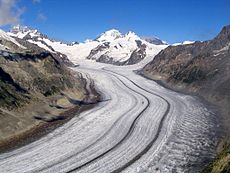
The Great Aletsch Glacier is the longest glacier in the Alps.

Satellite image of Switzerland
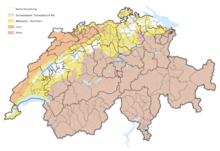
Major landscape areas; the Pre-Alps are not differentiated from the Alps (map with a municipality inventory as of January 1, 2021).
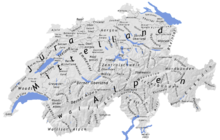
The natural layout of Switzerland
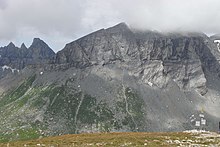
Glarner Hauptüberschiebung with Atlas (right) and Tschingelhörnern (left)

The Matterhorn in Zermatt (VS)
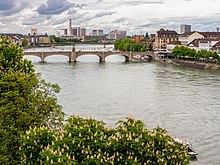
The Rhine in Basel as Switzerland's gateway to Europe
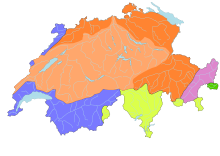
European river basins in Switzerland: Rhine (Alpine Rhine, Thur, Birs) Rhine (Aare, Reuss and Limmat) Rhone Po Adige Danube
Nature
Switzerland is home to an estimated 40,000 animal species, of which about 30,000 are insects and only about 83 are mammals. At least 40 percent of the animal species are endangered, especially amphibians and reptiles.
The Swiss water network comprises around 65,300 km of rivers and streams. The right of access allows everyone in Switzerland to move freely in nature under certain restrictions. Picking berries and mushrooms is also permitted with restrictions. In some cantons, fishing is allowed on certain waters within the framework of the free fishing right under certain conditions without a permit, otherwise a patent is required. Hunting is organized as district hunting in the northern cantons, and as patent hunting in most other cantons; see also Hunting Law (Switzerland).
Flora and vegetation
One third of Switzerland's land surface is forested. In the Alps, conifers (firs, spruces, larches and Swiss stone pines) dominate. The forests in the Alps have important functions as avalanche barrier forest and flood protection (the forest catches the rainfall and releases it only slowly). Mixed deciduous forests and broadleaf forests grow in the Central Plateau, in the Jura and on the southern side of the Alps below 1,000 meters. Particularly well known forest areas in Switzerland are the Aletschwald, the Sihlwald and the Pfynwald as well as the alpine primeval forests Bödmerenwald (untouched core area approx. 150 hectares), the primeval fir forest of Lac de Derborence (22 hectares), the spruce forest Scatlè near Brigels in the canton of Grisons (9 hectares) as well as the forest reserve Val Cama - Val Leggia in Misox. The Tamangur in the Lower Engadine is the highest Swiss stone pine forest in Europe. In Ticino and Misox there are extensive chestnut forests as a regional speciality, which in former times played a main role in the nutrition of the population. The three largest contiguous forests in Switzerland are located in southern Switzerland and on the Jura heights. These are forest areas west of the Maggia (169 km²), between Monte Tamaro and Roveredo (162 km²) and at the Col du Mollendruz to the national border at La Dôle (117 km²). More than 700 plant species in Switzerland are considered to be threatened with extinction.
In the valleys of the Ticino and sporadically in the Central Plateau, some palm species grow as ornamental plants, for example the dwarf palm or the Chinese hemp palm. The latter palm species has gone wild and, since it encroaches on native woody plants, it is listed as an invasive neophyte in the black list of invasive neophytes.
See also: List of woody plants in Switzerland
Fauna
There are about 99 mammal species living in the wild in Switzerland, most of which are bats and other small mammals. All large predators have disappeared from Switzerland in the last hundred years. The importance of predators in a healthy ecosystem was recognized and lynx, wolf and bear were placed under protection. The lynx was reintroduced into Switzerland. The wolf migrated independently from Italy and France. In the southeastern part of the Grisons, since 2005, brown bears coming from Italy, which had disappeared since 1910 due to hunting, are also occasionally found on Swiss territory, without, however, being able to form a population so far. The most frequently observed species is the red fox. It also feels very comfortable in Swiss cities. Badgers often live together with foxes in the same burrow, which is why they suffer from the persecution of foxes. As other burrow dwellers there are marmots in some Alpine regions. Besides the lynx, there are still isolated populations of wild cats in Switzerland in the Jura. Otters have disappeared from Switzerland since 1990, last traces were found in 1989 at Lake Neuchâtel. The main reason is probably the condition of the waters and the resulting reduced fish stocks. The stone marten is often found in settlements. Its relative, the pine marten, is rather rare and keeps its distance from humans. The first golden jackal was sighted in 2011.
Among ungulates, several species have also disappeared from Switzerland, such as the bison and the elk. Some extinct species, such as the Alpine Ibex, have since been reintroduced; it inhabits the high mountains of the Alps. In the lower Valais there are two colonies of European mouflon, which have migrated from France. The chamois is very common in the higher regions of the Alps as well as in the Jura. The largest deer species is currently the red deer. The smallest native deer species is the roe deer. The roe deer is also the most common deer species and inhabits the Mittelland and Jura. In the border area between Zurich and Schaffhausen near the Rafzerfeld the Sika deer is found. In the turmoil of the Second World War, some animals escaped from southern German enclosures and from there colonized Switzerland. Also quite common in some areas of northern Switzerland is the wild boar. Of the rodents, the beaver was reintroduced.
Switzerland is home to numerous bird species. Swiss lakes and rivers are important resting and wintering areas for waterfowl. For example, several thousand herons, pochards and cob ducks, as well as coots, goosanders and great crested grebes winter in Switzerland every year. Of the birds of prey, the kestrel and buzzard are particularly common. But also red and black kites occur regularly. The golden eagle again colonizes the entire Alpine region. The populations of goshawk and sparrow hawk have also recovered and are stable. The extinct bearded vulture was released in the Swiss National Park; in 2007, three pairs bred in Switzerland for the first time.
Of the grouse, hazel grouse, rock ptarmigan, black grouse and capercaillie inhabit the Swiss Alps and partly the Jura Arc. However, the populations of the capercaillie are highly endangered due to alpine tourism as well as the intensification of forestry. Thus, the capercaillie has already disappeared from many areas of the Pre-Alps and the northern Jura. However, nature conservation organizations are making intensive efforts to preserve the species. The rock partridge inhabits areas near the timberline. The partridge, corncrake and curlew are critically endangered.
Switzerland is home to owl species such as the tawny owl, long-eared owl, Eurasian eagle owl, pygmy owl, rough-legged owl and barn owl. Many woodpecker species live in the old mountain forests. Songbirds are numerous in Switzerland. Due to the expansion of the settlement area, the intensification of agriculture also in ever higher mountain regions as well as winter tourism, many bird species in Switzerland are endangered. Overall, almost 40 percent of bird species in Switzerland are on the Red List of endangered species. In the case of eagle owls and white storks, electrocution is one of the most common known causes of death, according to Daniela Heynen of the Sempach Ornithological Institute (see Bird Strike).
Reptiles include many species of snakes that thrive in the sunny southern valleys of the Alps, such as the asps viper. The adder also lives in the high altitudes of the Alps and the Jura. Far more common and widespread, however, are non-poisonous snakes such as the grass snake and the dice snake. Various species of lizards are very widespread. The only species of turtle found in Switzerland is the European pond turtle.
Amphibians are widespread in Switzerland. The grass frog, the common toad and the alpine newt are common. Much rarer, however, are the tree frog, the midwife toad and the alpine crested newt. The most typical vertebrate of Switzerland is the Alpine salamander - its largest populations and the center of its distribution are the Swiss Alps.
There are about 65 native fish species and subspecies in Swiss waters, including a unique variety of whitefish. In addition, there are about 20 introduced fish species. There are also four native crayfish species (noble crayfish, Italian jackdaw crayfish, jackdaw crayfish, stone crayfish) and 4 introduced crayfish species. Since the 19th century, fish stocks have also been artificially renewed by stocking measures, especially since the 1980s. Several hundred million juvenile fish are released each year.
Nature Conservation
The aim of nature conservation in Switzerland is "to preserve and protect the country's native landscape and townscape, historical sites and natural and cultural monuments, and to promote their preservation and maintenance". Nature conservation is legally regulated in the Federal Law on the Protection of Nature and Cultural Heritage (NHG). Partial regulations also exist in the forest and agricultural legislation of the federal government and the cantons. There are around 300 rangers working throughout Switzerland.
Currently (as of May 2016), 16 parks of national importance are in operation and 3 are in the process of being established. Probably the best known of these is the Swiss National Park in the canton of Graubünden, founded in 1914. Two parks are also designated as biosphere reserves. 165 protected landscapes are listed in the Federal Inventory of Landscapes and Natural Monuments of National Importance.
In Switzerland, there are 1073 natural forest reserves, including the Swiss National Park, with a total area of 46,199 hectares, which corresponds to 3 percent of the Swiss forest area (as of 12/2018).
Private organizations also take care of domestic nature conservation, such as Pro Natura, which contractually safeguards over 600 nature reserves in Switzerland with a total area of almost 600 km², or the Swiss Bird Protection.
Since 1987, fens and raised bogs have been strictly protected by the Federal Constitution (Rothenthurm Initiative). In 2007, the federal inventory of fens of national importance listed 1,163 fens worthy of protection with a total area of about 20,000 hectares, and the federal inventory of raised bogs of national importance includes 549 fens with a total area of about 1,500 hectares. This corresponds to about 0.04 % of the national area.
In 2019, Lancy became the first municipality to be certified Bio-Suisse.
Not enough areas have been registered for the Emerald Network until 2020. So far, only 37 Smaragd areas exist. Of all European countries, Switzerland has the lowest proportion of protected areas in relation to its land area. Among other factors, tourism, expansion of settlement areas, intensification of agriculture, pollution and overuse of resources contribute to biodiversity loss. In 2020, BirdLife Switzerland concluded that Switzerland has done far too little to protect its rich biodiversity. The OECD and the European Environment Agency also point out that the measures taken so far to protect biodiversity are far from sufficient.
Zoological gardens
Various zoos and animal parks show visitors native as well as exotic animals. Among the most famous zoological gardens in Switzerland are the Basel Zoo, the Zurich Zoo with its Masoala Hall, Knies Children's Zoo and the Bern Bear Park.
See also: List of zoological gardens and aquariums in Europe (section Switzerland)

Swiss National Park with Rhaeto-Romanic information board
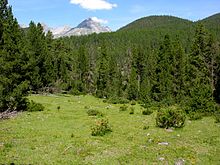
The vegetation in the Swiss National Park in Zernez (GR)
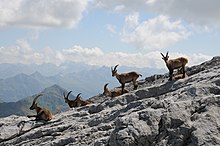
Alpine ibex in the Rätikon
Population
Cities and municipalities
→ Main article: Municipality (Switzerland), Political municipality and List of cities in Switzerland.
The smallest political unit is the municipality. Thus, cities also count as municipalities. As of January 1, 2021, there were 2172 political municipalities. The number has decreased significantly in recent years due to mergers of municipalities.
The largest city in Switzerland is Zurich with 420,217 inhabitants (December 31, 2019), and the smallest municipality is Kammersrohr with 32 inhabitants (December 31, 2019). Other large cities include Geneva with 203,951 (December 31, 2019), Basel with 173,232 (December 31, 2019), Lausanne with 139,408 (December 31, 2019), the federal city of Bern with 134,591 (December 31, 2019), and Winterthur with 113,173 (December 31, 2019) residents. The largest cities with fewer than 100,000 inhabitants are Lucerne (82,257), St. Gallen (76,090), Lugano (62,615), and Biel/Bienne (55,602) (all as of December 31, 2014).
Around 1,369,000 people live in the Zurich agglomeration, 592,100 in the Geneva agglomeration, 547,800 in the Basel agglomeration, 420,800 in the Lausanne agglomeration and 418,200 in the Bern agglomeration (December 31, 2017). Overall, almost three quarters of the population live in one of the 49 Swiss agglomerations.
Since January 1, 2015, the largest political municipality by area has been the municipality of Scuol (Canton of Graubünden), which was created by merger, with 438 square kilometers; previously, the largest municipality by area was the municipality of Glarus Süd (Canton of Glarus), which was also created by merger, with 430 square kilometers. The smallest municipalities by area are Gottlieben (Canton Thurgau), Kaiserstuhl (Canton Aargau) and Rivaz (Canton Vaud), each with 0.32 square kilometers.
See also: List of German names of Swiss places, List of French names of Swiss places and List of Rhaeto-Romanic names of Swiss places.
Swiss citizenship
→ Main article: Swiss citizenship, Swiss and list of known Swiss persons
Swiss citizenship is the common name for Swiss nationality. According to Art. 37 para. 1 of the Federal Constitution, it cannot be acquired without simultaneously acquiring the citizenship of a municipality and the citizenship of the canton. Municipal and cantonal citizenship confer Swiss citizenship.
The municipality whose (municipal) citizenship a Swiss citizen holds is called Bürgerort (also Heimatort).
The Swiss passport and identity card serve as proof of citizenship of the Swiss Confederation.
Switzerland's nationality law is restrictive by international standards, and the cantons each have different regulations. Children born in Switzerland to foreigners living in the country do not automatically receive citizenship.
Swiss people who live abroad are called Swiss Abroad and, moreover, the Fifth Switzerland. This expression is explained by the four language regions of Switzerland. At the end of 2018, 760,200 Swiss nationals lived abroad, of which 62% were in Europe, 16% in North America, 8% in South America, 7% in Asia, 4% in Australia and 3% in Africa (statistics of those registered with a Swiss representation abroad).
Demographics
Long-term population development
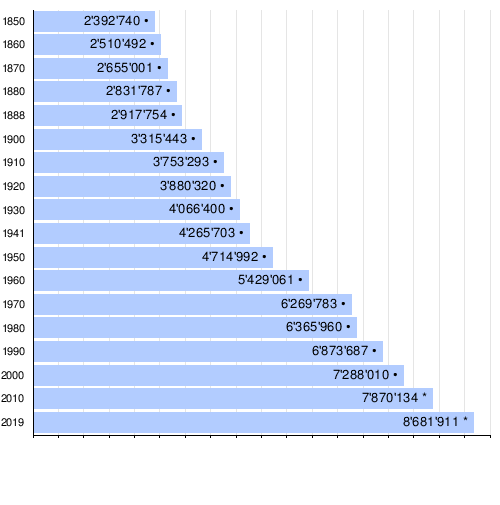
Population development as of 2010
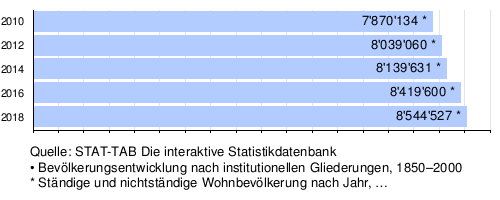
→ Main article: Demography of Switzerland
Since the beginning of the 20th century, the population has more than doubled: from 3.3 million (1900) to 8.5 million (2018). Population growth leveled off to 0.7 percent in 2018. Population growth peaked between 1950 and 1970, with population declines occurring only in 1918 as a result of the Spanish flu and in the economic recession years 1975-1977. While a total of 148,799 people immigrated to Switzerland in 2012, 96,494 left the country.
Since 1981, the growth of the population with a Swiss passport has been slower and more constant than that of the total population. The development of the foreign resident population has been somewhat faster, but more irregular over the years - with relatively high annual growth rates between 1988 and 1993 of about 3 percent each.
While the general birth rate was still 2.67 in 1963, it declined steadily thereafter to a value of 1.38 in 2001. Since then, there has been a moderate increase again to 1.46 in 2007, which also resulted in a birth surplus of Swiss nationals for the first time in ten years (+400). In 2018, the birth rate was 1.52 children per woman.
According to the Federal Statistical Office, life expectancy in 2019 was 85.6 years for women and 81.9 years for men. According to the UN, Switzerland was the country with the second highest life expectancy in the world in the period from 2015 to 2020.
Population density is very high - by Swiss standards - in the flat Central Plateau, with about 450 persons per square kilometer on 30 percent of the national territory, and naturally thin in the Alpine region and the Jura. In the canton of Graubünden, located in the Alpine region, the population density is only a fraction of this (about 27 persons per square kilometer). In addition, the Central Plateau, but also the canton of Ticino, is highly urbanized.
See also: Geography of Switzerland (section resident population)
Slowing immigration is having an impact on the real estate market: for example, the number of vacant apartments rose from 40,000 to 65,000 between 2013 and 2017, according to the Federal Statistical Office. As a result, rents are also falling.
In Switzerland, a distinction is made between foreigners (population without Swiss citizenship) and the population with a migration background (population with Swiss citizenship as well as foreign roots). The term secondo is the common term in Switzerland for second-generation immigrants who are partly foreigners and partly Swiss nationals.
Foreigners
Foreigners are persons without Swiss citizenship (the official term for Swiss nationality). At the end of 2017, 2,126,400 residents lived in Switzerland without Swiss citizenship, which corresponded to 25.1 percent of foreigners, most of them from Italy (317,300), Germany (304,600), Portugal (266,600) and France (131,100) Every foreigner receives a foreigner's identity card. Since the beginning of the 19th century, the percentage of foreigners in the total Swiss population has been higher than in other European countries. Reasons for this include the many border regions, the central location in Europe and the small size of the country. Others see the reason more in the restrictive legislation that prevents faster naturalizations. While the average proportion of foreigners in the country as a whole is 25.1 percent, some municipalities have a much higher than average proportion. These include, for example, Basel (37.3%), Lausanne (43.2%), Dietikon (45.0%), Montreux (46.5%), Geneva (47.9%), Spreitenbach (50.3%), Renens (51.2%), Kreuzlingen (54.7%).
Population with migration background
The population with a migration background includes persons who immigrated to Switzerland and whose two parents were born abroad. It also includes the immediate (direct) descendants of these persons (so-called secondos, members of the second generation) who were born in Switzerland.
A person with a migration background can have both Swiss and foreign citizenship.
Consequently, third-generation foreigners and native-born Swiss with at least one parent born in Switzerland are not persons with a migration background. As of the end of 2013, the Federal Statistical Office (FSO) determined that 34.8 percent (2,374,000 inhabitants) of the resident population aged 15 and over throughout Switzerland had a migrant background.
Asylum
Switzerland complies with its obligations under international law in accordance with the Geneva Convention on Refugees. The legal basis is the Asylum Act (AsylG). The responsible federal authority is the State Secretariat for Migration (SEM). Asylum seekers and refugees, like all other foreigners, receive a foreigner's identity card: the "N" card is issued to asylum seekers, "F" to temporarily admitted foreigners and "S" to those in need of protection.
In 2014, 23,765 people applied for asylum in Switzerland. Of the asylum seekers, the majority came primarily from Eritrea, followed by Syria and Sri Lanka. In 2015, 39,523 people applied for asylum, mainly from Eritrea, Afghanistan and Syria.
Sans-Papiers
People living in Switzerland without a valid residence permit are called Sans-Papiers (literally "[people] without papers"). Their number is, by nature, unknown. Estimates vary between 80,000 and 300,000 people; in a 2015 study, the Federal Statistical Office (FSO) puts the number at around 76,000. Most sans-papiers are employed in "low-skilled" jobs. Sans-Papiers work in industries whose personnel needs are not fully covered by Swiss or EU nationals. They clean in private households, look after children and the elderly, work on construction sites or in agriculture.
Emigration
For young men, joining foreign military services as mercenaries was the most common form of emigration until the first third of the 19th century. From the 14th century onward, the so-called Reisläufer were in the service of the emperor, the French kings and Italian cities such as Milan (→ Swiss troops in foreign service).
Hunger and poverty after the Thirty Years' War led to waves of emigration to East Prussia. At the beginning of the 19th century, war-related (→ Napoleonic Wars) general impoverishment led to emigration to Russia, while Latin America in particular was the destination during the famine years of 1816-1817 (→ year without summer). The agricultural crises of the 1840s, 1870s, and 1880s, as well as restructuring problems during industrialization, led to mass emigration on an unprecedented scale overseas, especially to North America and South America. By the end of the 19th century, North America was the destination for nearly 90 percent of emigrants. Between 1851 and 1860, some 50,000 people emigrated overseas, 35,000 each in the 1860s and 1870s, and over 90,000 between 1881 and 1890. Until 1930, the number of emigrants stabilized between 40,000 and 50,000 per decade. In some cantons, the poor were urged to emigrate on a large scale by the authorities.
The emigrants founded colonies in the New World, thus Nouvelle Vevay (today New Vevay) in Indiana was founded in 1803, New Switzerland in Illinois in 1831 and New Glarus in Wisconsin in 1845. Probably the most famous emigrant was Johann August Sutter. A California landowner who became known as General Sutter, he founded the private colony of New Helvetia. It was on his land that the California Gold Rush broke out in 1848.
According to empirical data, the migration balance for the area of present-day Switzerland was always negative from the second half of the 16th century until the end of the 19th century.
See also: List of American Swiss
Immigration
Today, Switzerland - like almost all prosperous Western countries in the world - is a country of immigration. At the time of industrialization, there was a large internal migration, especially from the Alps. Since the great economic growth in the 1960s, guest workers (→ Saisonnierstatut) were recruited in a targeted manner, and later refugee flows repeatedly reached Switzerland, for example from the former Yugoslavia during the Yugoslav wars. From Turkey, many guest workers came to Western Europe and thus also to Switzerland. After 8544 people (including 4876 Germans) moved from Germany to Switzerland in 1992, there were 14,792 (11,225) in 2003 and 35,061 (29,139) in 2008. After that, immigration from Germany decreased to 25,881 (19,930 Germans) in 2014. In 2015, 106,805 people from the EU/EFTA immigrated and 55,111 EU/EFTA nationals left Switzerland. In 2008, only slightly more people, 113,235, had immigrated from the EU/EFTA. A few thousand people from third countries obtain a labor market permit each year.
In 2017, Italian citizens made up the largest group of foreigners at 14.9 percent, followed by German (14.3 percent), Portuguese (12.5), French (6.2), Kosovar (5.2), Spanish (3.9), Turkish (3.2) and Serbian (3.1) citizens. The rest of Europe accounted for 19.9 percent, Asia for 7.9 percent, Africa for 5.1 percent and America for 3.8 percent.
42,699 people, mainly from Italy, Germany, Portugal, France and Kosovo, were naturalized in 2015. In 2008, 45,305 people had been naturalized, especially from Kosovo, Italy, Germany and Turkey.
See also: List of migration groups in Switzerland
Languages
→ Main article: Languages in Switzerland
The Federal Constitution of the Swiss Confederation (FC) uses the terms national languages and official languages.
Article 4 of the Federal Constitution has stated since 1999:
"The national languages are German, French, Italian and Romansh. »
Article 70(1) BV also states:
"The official languages of the Confederation are German, French and Italian. In dealings with persons of Rhaeto-Romanic language, Rhaeto-Romanic shall also be the official language of the Confederation. »
According to a survey conducted by the federal authorities in 2020, German (pale red on the map opposite) is the most widely spoken language, accounting for 62 percent of the total population. In the German-speaking part of Switzerland, Swiss German dialects (→ Swiss German) and, to a lesser extent, (Swiss) High German are spoken, while written material is generally written in Swiss High German. This is the term for the written German language used in Switzerland. It is the Swiss variety of Standard German (High German) and differs from it in vocabulary, word formation, morphology, syntax, orthography (e.g., no "ß"), and pronunciation. These peculiarities are called Helvetisms. Swiss German belongs to the Swabian-Alemannic linguistic area of the German language.
French (purple) is spoken by 23 percent of the total population (→ Swiss French). This part of the country is often referred to as Romandie, Suisse romande, Welschland or Westschweiz, where only a small minority still speak patois (dialects) in addition to the standard French that predominates today.
Italian is spoken in the canton ofTicino and four southern valleys (Misox, Calanca Valley, Bregaglia, Puschlav) as well as the municipality of Bivio in the canton of Graubünden (Grigioni italiano) (green). This applies to 8 percent of the total population in Switzerland (→ Swiss Italian). A large, albeit declining, proportion of the Italian-speaking population speaks local dialects belonging to Lombard ("Ticinées").
The fourth national language, Romansh (yellow), accounts for 0.5 percent of the total population and is spoken in Graubünden, with virtually all Romansh speakers also speaking German. Romansh has been severely endangered since the 19th century and, despite promotional measures, is increasingly being displaced by German. Since 1860, 51 communities in Graubünden have switched from Romansh to German. In 1938, the voting people adopted a constitutional amendment whereby Romansh was elevated to the status of national language. Only since 1996 has Romansh also been considered an official language. Since 2001, the written language Rumantsch Grischun has been the official language in the canton of Graubünden and in the federal government for communication with the Romansh-speaking population; in the Romansh communities, however, one of the five Romansh idioms still serves as the official language.
The Federal Constitution does not define the language areas of Switzerland. Art. 70 para. 2 BV assigns the cantons the competence to determine their official languages. In doing so, however, they must respect linguistic minorities and the traditional composition of the language areas. Anyone moving from a part of the country with a different language has no right to communicate with the new cantonal and communal authorities in his or her native language (territoriality principle). Among the multilingual cantons, only Bern and Valais have spatially defined language areas; the multilingual canton of Fribourg assigns the regulation of the official language to the communes. Officially bilingual by cantonal constitution are the municipalities of Biel/Bienne, Evilard/Leubringen and Fribourg/Fribourg at the interface between French and German. Some other communes, such as the seven of the Murten/Morat school district and those in the vicinity of Biel, also offer bilingual services and schools in both cantonal languages to accommodate the French-speaking minority.
In the canton of Graubünden, according to Art. 16 of the Graubünden Municipal Law of 2006, municipalities are considered officially monolingual if at least 40 percent of the inhabitants speak the ancestral language, and bilingual if at least 20 percent speak the ancestral language. In fact, this can mean that Romansh is the administrative and school language there, but Swiss German is the lingua franca. The canton of Ticino defines itself as belonging entirely to the Italian language area and the canton of Jura as belonging entirely to the French language area, although one municipality each (Jura: Ederswiler, Ticino: Bosco/Gurin) has a German-speaking majority.
The number of Travellers, among whom the Yenish, along with a smaller number of Sinti and Roma, form the vast majority, is not recorded in censuses, but official estimates put it at 20,000 to 35,000. This would correspond to a share of approximately 0.5 percent. Yenish live scattered throughout Switzerland and speak, in addition to their internal group language Yenish, mostly one of the national languages. Yiddish (Western Yiddish) has an old tradition in Switzerland in the Surbtal villages of Endingen and Lengnau due to the Jewish communities there, which now exist only marginally. Yiddish (Eastern Yiddish) has a more recent tradition in the city of Zurich, where it is partly spoken in ultra-Orthodox circles. Speakers of Yenish and Yiddish have been considered national non-territorial "minority communities" by Switzerland since 1997 under the European Charter for Regional or Minority Languages, but their languages are thus not recognized as national minority languages.
Sign languages are spoken by about 10,000 people living in Switzerland. In Switzerland, the Swiss German Sign Language (DSGS), the Langue des signes Suisse romande (LSF-SR, West Swiss Sign Language) and the Lingua dei segni della Svizzera italiana (LIS-SI, Ticino Sign Language) are used.
Another main language is spoken by 25 percent of the total population. Due to immigration, 9 percent of the population now speaks languages other than the national languages. Of these, Serbian-Bosnian-Croatian is the most widespread, with 1.5 percent.
As foreign languages, the Swiss learn a second national language and English. There are discussions about whether English should be taught simultaneously with or even before the second national language. Due to protests from the respective other language region and fundamental considerations about the cohesion of Switzerland, a purely English foreign language teaching has not been able to gain acceptance anywhere so far.
Religions
→ Main article: Religions in Switzerland
Of the total Swiss resident population, 3,213,411 people (37.9 percent) were members of the Roman Catholic Church and 2,150,387 people (25.3 percent) were members of the Protestant Reformed Church in 2017 (100 percent: 8,484,130 people).
Of the resident population aged 15 and older, 35.9 percent were Roman Catholic, 26.0 percent were nondenominational, 23.8 percent were Protestant Reformed, 5.9 percent belonged to other Christian communities (free churches, Christian Catholics and Orthodox Christians), 5.4 percent belonged to Islamic communities, 1.6 percent belonged to other religious communities (including 0.3 percent Jews) and 1.4 percent did not specify, according to a 2017 survey by the Federal Statistical Office (FSO).
According to a 2017 study by the Pew Research Center, 75% of the adult population in Switzerland describe themselves as Christians - regardless of whether they officially belong to a particular Christian denomination or church, e.g. by paying a church tax. However, only 27 % of Christians attend a church service at least once a month. 21 % of respondents do not feel they belong to any religion, with almost half of them describing themselves as atheists.
Freedom of religion in Switzerland is enshrined as a fundamental constitutional right. It is left to the cantons to decide whether they wish to grant selected religious communities special status as public-law corporations and thus as national churches. In most cantons, the Roman Catholic Church and the Protestant Reformed Church, in many cantons additionally the Christian Catholic Church and in some the Jewish communities have this status. In 1973, in the canton of Basel-Stadt, the Israelite Community of Basel (IGB) became the first Jewish community in Switzerland to be recognized by the canton under public law. The cantons of Bern, Fribourg, St. Gallen, Vaud and Zurich now have the same status. The Christian Catholic Church is only significant in parts of northwestern Switzerland. In the French-speaking cantons of Geneva and Neuchâtel, there are no national churches because church and state are completely separate there; they are nevertheless recognized as "organizations of public interest". In Basel, there is the so-called "limp separation" of church and state.
At 0.33 percent, Buddhism is more strongly represented in Switzerland than in other European countries. Synagogues, mosques (→ List of mosques in Switzerland) and Buddhist temples exist in several places in Switzerland.
Historically, the inhabitants of the cantons of Zurich, Bern, Basel-Stadt, Basel-Landschaft (except for the district of Arlesheim), Schaffhausen, Appenzell Ausserrhoden and Vaud were still almost exclusively Reformed around 1850, while those of the cantons of Fribourg (except for the district of Murten), Valais, Jura, Solothurn (except for the district of Bucheggberg), Lucerne, Ob- and Nidwalden, Uri, Schwyz, Zug, Appenzell Innerrhoden and Ticino were almost exclusively Catholic. The cantons of Glarus, Aargau, St. Gallen, Graubünden and Geneva, on the other hand, were confessionally mixed. The distribution of confessions was the result of the application of the territorial principle in the choice of confession after the religious wars of the 16th century; the confessionally mixed cantons either had young cantonal boundaries (Aargau, St. Gallen, Geneva) or knew an old-established communal definition (Glarus, Grisons). Parity, i.e. the simultaneous presence of both confessions in the same place, was the exception; it applied, for example, in Toggenburg, in parts of the former subject territories of the Confederation (Thurgau, Echallens) and in some municipalities of Graubünden and Glarus.
A referendum in 1919 in Vorarlberg on negotiations with Switzerland on joining the Swiss Confederation resulted in approval by a good 80 percent, but further negotiations failed because of the Reformed in Switzerland, who would have lost their majority at the time if an additional canton had Catholics.
Niklaus von Flüe is considered the patron saint of Switzerland.
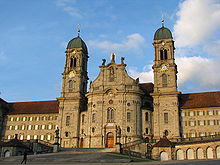
Einsiedeln Monastery (SZ)

Denominational areas per municipality (2017)
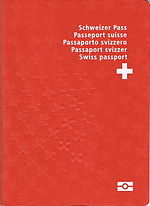
The Swiss passport (2010)

Share of foreigners per municipality (2019)
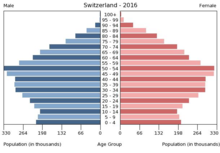
Population pyramid of Switzerland 2016
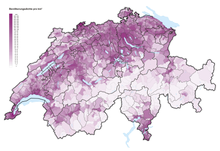
Population density per municipality (2019)
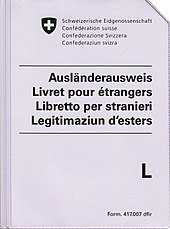
Example of a foreigner's identity card: lilac - "L" for short-term residents with up to one-year stay
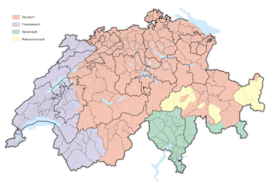
Language areas of Switzerland - majority ratio according to the 2010 FSO survey; map with a municipality population as of January 1, 2021 German (62 % of the population) French (23% of the population) Italian (8% of the population) Romansh (0.5% of the population)

Swabian-Alemannic language area in the 19th and 20th centuries

The Great Synagogue of Basel
Right
→ Main articles: Fundamental rights (Switzerland) and Political system of Switzerland#Judicature
Politics
Switzerland's politics are shaped by its self-image as a nation of wills - its national identity is not based on a common language and culture, but rather, among other things, on its shared history, common myths, its liberal, grassroots democratic and federalist tradition, and partly on the feeling that it is a "special case" in Europe as a neutral and multilingual "small state" that stands on its own. A directorial system is in place.
These preconditions have resulted in a political system that is unique in its entirety, with federalism, expanded political popular rights or elements of direct democracy, foreign policy neutrality and domestic political consensus at the forefront.
See also: Direct democracy in Switzerland and List of federal referenda
Political system
→ Main article: Political system of Switzerland
Switzerland is a republican federal state. It differs from other republics by
- Elements of direct democracy: The people can exert direct influence on government activity through initiatives and referendums. In two cantons, Appenzell Innerrhoden and Glarus, there is still an original form of Swiss grassroots democracy: the Landsgemeinde.
- the pronounced federalism: the cantons, along with the people, are the constitutional legislators of the Confederation and retain all tasks that are not explicitly assigned to the Confederation in the Federal Constitution. In addition, strong participation of the cantons in all phases of political decision-making (consultation, Council of States, majority of the cantons).
- the concordance democracy
- its self-declared Swiss neutrality
As is customary in democracies, state power is divided into three pillars, based on the Federal Constitution of the Swiss Confederation:
- The legislature (Federal Assembly) consists of two chambers, the National Council with 200 members representing the people and the Council of States with 46 members representing the cantons. The Swiss parliament is a so-called militia parliament: The members of the National Council and Council of States exercise their mandate (at least nominally) on a part-time basis. Renewal elections take place every four years (→ Swiss parliamentary elections 2019).
- The executive branch is the Federal Council with the administration. It consists of seven members with equal rights (collegiality principle), the so-called "Bundesräte" (ministers), each of whom heads a department of the federal administration. The Federal Councillors are elected by Parliament. One member of the Federal Council is elected President of the Confederation by the Federal Assembly for a term of one year at a time. He presides over the meetings of the Federal Council and performs representative duties at home and abroad, but has no prerogatives over the rest of the Federal Council. Usually, the presidency rotates based on seniority, and the actual election is generally considered a formality to confirm it; however, rejection by Parliament is theoretically possible. During this year, the President of the Confederation is usually addressed in public as Mr. President of the Confederation, Madam President of the Confederation, rather than as Mr. Federal Councillor or Madam Federal Councillor. During the presidential year, a Federal Councillor performs his or her usual government duties in full.
- At the federal level, the judiciary consists of the Federal Supreme Court with its seat in Lausanne and two social law divisions of the Federal Supreme Court in Lucerne (until 2006: Federal Insurance Court) as the highest judicial instance. The lower federal instances are the Federal Criminal Court in Bellinzona and the Federal Administrative Court and the Federal Patent Court, both in St. Gallen. The federal judges, most of whom belong to a political party, are elected by the Federal Assembly. The Criminal Court began work in 2004; the Administrative Court did so in 2007.
A special constitutional court, as in other countries, does not exist in Switzerland, but all courts can exercise (limited) constitutional jurisdiction. According to Art. 190 of the Federal Constitution (BV), federal laws are binding on the Federal Supreme Court and the other courts; they cannot repeal, invalidate or refuse to apply such laws.
The order of the individual Federal Councillors is as follows: The President of the Confederation is at the top of the ranking list, followed by the Vice-President. This is followed by the Federal Councillors in order of seniority for re-election in accordance with the principle of anciennity.
As part of the 2019 election of the Federal Council, the United Federal Assembly elected the seven Federal Councilors and the Federal Chancellor on December 4, 2019. All seven previous Federal Councillors were re-elected. The current composition of the Federal Council with party affiliation and distribution of departments is:
- Guy Parmelin (SVP/VD), President of the Swiss Confederation 2021, Federal Department of Economic Affairs, Education and Research EAER
- Ignazio Cassis (FDP/TI), Vice President 2021, Federal Department of Foreign Affairs FDFA
- Ueli Maurer (SVP/ZH), Federal Department of Finance FDF
- Simonetta Sommaruga (SP/BE), Federal Department of the Environment, Transport, Energy and Communications DETEC
- Alain Berset (SP/FR), Federal Department of Home Affairs FDHA
- Viola Amherd (CVP/VS), Federal Department of Defense, Civil Protection and Sport DDPS
- Karin Keller-Sutter (FDP/SG), Federal Department of Justice and Police FDJP
The Federal Chancellor of the Swiss Confederation and thus head of the Federal Chancellery (FC) has been Walter Thurnherr (CVP/AG) since December 2015.
See also: List of Swiss Federal Presidents, List of Members of the Swiss Federal Council and Protocol Order of Precedence in Switzerland.
Political indices
| Political indices published by non-governmental organizations | ||||
| Index name | Index value | Global rank | Interpretation aid | Year |
| Fragile States Index | 17.1 from 120 | 176 from 178 | Stability of the country: very sustainable | 2020 |
| Democracy Index | 8.83 from 10 | 12 from 167 | Full democracy | 2020 |
| Freedom in the World Index | 96 from 100 | - — | Freedom status: free | 2020 |
| Press Freedom Ranking | 10.55 from 100 | 10 from 180 | Good situation for press freedom | 2021 |
| Corruption Perception Index (CPI) | 85 from 100 | 3 from 180 | 0 = very corrupt / 100 = very clean | 2020 |
State budget
In 2016, the national budget comprised expenditures of the equivalent of 213.4 billion U.S. dollars, which were offset by revenues of the equivalent of 215.9 billion U.S. dollars. This resulted in a budget surplus of 0.1 percent of gross domestic product.
Public debt amounted to 45.4 percent of gross domestic product in 2016.
In 2006, government spending (as a percentage of GDP) in health was 10.8 percent; in education, 5.8 percent in 2005; and in military, 1.0 percent in 2005.
In 2016, the Confederation recorded revenue (income) of CHF 67.01 billion. The most important source of revenue was value-added tax (three different rates) at 34.0 percent, followed by direct federal tax at 31.0 percent, withholding tax (8.0 percent), mineral oil tax (7.0 percent), tobacco tax (3.0 percent), stamp duties (3.0 percent), other fiscal revenues (8.0 percent), and non-fiscal revenues (7.0 percent).
In 2016, the federal government made expenditures (outlays) of 66.26 billion francs on the following sectors: social welfare (34.0 percent), finance and taxation (14.0 percent), transport (14.0 percent), education and research (11.0 percent), other expenditures (10.0 percent), national defense (7.0 percent), agriculture and food (6.0 percent), and relations with foreign countries (5.0 percent).
The revenues of the 26 cantons amounted to CHF 89.6 billion in 2016.
The debt brake, which has been enshrined in the Constitution since 2003, is intended to oblige the federal government to keep revenues and expenditures in balance over the economic cycle.
The rating agency Standard & Poor's has given Switzerland's government bonds an unchanged AAA rating since 1989 (as of 2018). Long-term interest rates for Swiss government bonds are very low by international standards (see chart on the right).
Political parties
→ Main article: Political parties in Switzerland
Switzerland has many national, regional and local political parties. The organization and financing of the parties is largely unregulated by law.
← 2015Total Renewal Elections of the
National Council 20192023 →
Voter turnout: 45.1
%
30
20
10
0
25,6
16,8
15,1
13,2
11,4
7,8
2,5
2,1
1,0
4,6
SVP
SP
FDP
Green
CVP
glp
BDP
EVP
EDU
Otherwise.
Gains and losses
compared to 2015
%p
8
6
4
2
0
-2
-4
−3,8
−2,0
−1,3
+6,1
−0,2
+3,2
−1,6
+0,2
−0,2
−0,3
SVP
SP
FDP
Green
CVP
glp
BDP
EVP
EDU
Otherwise.
| Four of the five parties with the highest voter strength are represented in the Federal Council (see also magic formula) | |||||
| Political party | Abbr. | Classification | Alignment | Voter share 2019 | |
| Swiss People's Party | SVP | right | national conservative | ▼ 25,6 % | |
| Social Democratic Party of Switzerland | SP | left | social democratic | ▼ 16,8 % | |
| FDP.The Liberals | FDP | Center-right | liberal | ▼ 15,1 % | |
| Green Party of Switzerland | Green | left | ecological | ▲ 13,2 % | |
| Christian Democratic People's Party | CVP | Center | christian democratic | ▼ 11,4 % | |
According to a 2016 opinion survey by the Gesellschaft für Konsumforschung (GfK), 19 percent of Swiss people have confidence in their politicians. Although this is a low figure compared to other occupational groups, trust is significantly higher than the Western European average of 13 percent.
Cantons
→ Main article: Canton (Switzerland)
Switzerland consists of 26 cantons (before the total revision of the Federal Constitution of the Swiss Confederation in 1999: 23 cantons, three of which were divided into two half-cantons each). Traditionally, the cantons are also referred to as estates, and at the cantonal level as the state (French état).
The table below lists the 26 cantons with their key data. The cantons are sorted in the order in which they are listed in the Federal Constitution of the Swiss Confederation. The population figures are dated December 31, 2019, the percentages of foreigners are dated December 31, 2019, and the unemployment rates are dated January 31, 2021.
| Cantons with their key data | ||||||||
| Abbr. | Canton | Main site | Total area | Inhabitants | Inhabitants per | Foreigners | Unemployment rate | Official language |
| ZH | Canton Zurich | Zurich | 1729 | 1'539'275 | 890 | 27,1 | 3,6 | German |
| BE | Canton Bern | Bern | 5959 | 1'039'474 | 174 | 16,6 | 2,9 | German, French |
| LU | Canton Lucerne | Lucerne | 1493 | 413'120 | 277 | 18,8 | 2,7 | German |
| UR | Canton Uri | Altdorf | 1077 | 36'703 | 34 | 12,6 | 1,8 | German |
| SZ | Canton Schwyz | Schwyz | 908 | 160'480 | 177 | 21,9 | 1,7 | German |
| OW | Canton Obwalden | Sarnen | 491 | 37'930 | 77 | 14,7 | 1,4 | German |
| NW | Canton Nidwalden | Stans | 276 | 43'087 | 156 | 14,8 | 1,8 | German |
| GL | Canton Glarus | Glarus | 685 | 40'590 | 59 | 24,2 | 2,5 | German |
| ZG | Canton Zug | Train | 239 | 127'642 | 534 | 28,3 | 3,0 | German |
| FR | Canton Fribourg Fribourg | Freiburg | 1671 | 321'783 | 193 | 22,8 | 3,9 | French, German |
| SO | Canton Solothurn | Solothurn | 791 | 275'247 | 348 | 22,9 | 3,5 | German |
| BS | Canton Basel City | Basel | 37 | 195'844 | 5293 | 36,6 | 4,4 | German |
| BL | Canton Basel-Landschaft Basel-Landschaft | Liestal | 518 | 289'468 | 559 | 23,1 | 2,9 | German |
| SH | Canton Schaffhausen | Schaffhausen | 298 | 82'348 | 276 | 26,1 | 4,3 | German |
| AR | Canton Appenzell Ausserrhoden | Herisau, Trogen1 | 243 | 55'445 | 228 | 16,5 | 2,2 | German |
| AI | Canton Appenzell Innerrhoden | Appenzell | 173 | 16'128 | 93 | 11,3 | 1,0 | German |
| SG | Canton St. Gallen | St. Gallen | 2026 | 510'734 | 252 | 24,4 | 2,9 | German |
| GR | Canton Grisons | Chur | 7105 | 199'021 | 28 | 18,8 | 2,0 | German, Romansh, Italian |
| AG | Canton Aargau | Aarau | 1404 | 685'845 | 488 | 25,3 | 4,0 | German |
| TG | Canton Thurgau | Frauenfeld | 991 | 279'547 | 282 | 25,2 | 2,9 | German |
| TI | Canton Ticino | Bellinzona | 2812 | 351'491 | 125 | 27,6 | 4,1 | Italian |
| VD | Canton Vaud | Lausanne | 3212 | 805'098 | 251 | 33,0 | 5,0 | French |
| VS | Canton Valais | Customs | 5224 | 345'525 | 66 | 22,6 | 4,9 | French, German |
| NE | Canton Neuchâtel | Neuchâtel | 803 | 176'496 | 220 | 25,3 | 5,1 | French |
| GE | Canton Geneva | Geneva | 282 | 504'128 | 1788 | 40,0 | 5,6 | French |
| JU | Canton Jura | Delémont | 838 | 73'584 | 88 | 14,7 | 5,7 | French |
| CH |
| Bern (Federal City) | 41285 | 8'606'033 | 208 | 25,3 | 3,7 | German (65.6%), French (22.8%), |
1 Herisau is the seat of the government and parliament of the Canton of Appenzell Ausserrhoden, the seat of the cantonal courts is Trogen. The former Landsgemeinde was held alternately in Trogen and Hundwil. Appenzell Ausserrhoden therefore has no clearly defined main town.
The cantonal governments are called - depending on the canton - Regierungsrat, Regierung, Staatsrat, Standeskommission, Conseil exécutif, Conseil d'État (both French), Consiglio di Stato (Italian) or Regenza Governo (Rhaeto-Romanic). The cantonal parliaments are organized as unicameral parliaments and are called Kantonsrat, Grosser Rat, Landrat, Grand Conseil (French), Gran Consiglio (Italian) or Cussegl grond (Rhaeto-Romanic).
The administrative level between the canton and the municipality is - as far as it occurs at all - called district in most cantons, administrative region, administrative district, electoral district, amtei, office in some cantons, district in the French-speaking part of the country, distretto in the Italian part of the country, districts in the Rhaeto-Romanic part of the country.
Due to federalism in Switzerland, responsibility for many state tasks lies wholly or partly with the cantons, for example in the areas of education, health, finance, police and justice, as well as administrative law. In order to manage these tasks efficiently and according to uniform principles, the cantons have concluded numerous intercantonal concordats. All cantons also belong to one of five regional conferences, which serve to provide them with mutual information, coordinate government activities and effectively represent their interests vis-à-vis the federal government. Furthermore, the cantons cooperate within the framework of the various directors' conferences (e.g. Swiss Conference of Cantonal Ministers of Education or Swiss Conference of Cantonal Ministers of Health). The secretariats of these conferences are located in the House of Cantons in Bern.
See also: List of incumbent members of the Swiss cantonal governments, List of coats of arms and flags of the Swiss cantons and List of Swiss cantons by gross domestic product
Enclaves and exclaves
Büsingen am Hochrhein as well as Campione d'Italia are enclaves in Switzerland. The German municipality of Büsingen is surrounded by the canton of Schaffhausen to the north of the Rhine, and borders the cantons of Zurich and Thurgau to the south. The Italian Campione, known for its gambling casino, is located on Lake Lugano within the Canton of Ticino. Under customs law, the two enclaves are to be treated differently as of January 1, 2020. While Büsingen is part of the Swiss customs territory, Campione is no longer so since January 1, 2020. Instead, the municipality has been part of the customs territory of the European Union since then.
For a long time the Italian Livigno was a functional enclave. Since the construction of a pass road, Livigno can also be reached from Italy. In order to make life in the nevertheless secluded location more attractive, the municipality is now an Italian customs exclusion zone, having previously been part of the Swiss customs territory.
For a long time, the municipality of Samnaun was a functional exclave, as the only access road led across Austrian territory until 1912. Today, the municipality is a Swiss customs exclave.
Foreign Policy
→ Main article: Swiss foreign policy
Switzerland considers itself to be neutral in terms of foreign policy, i.e. it does not participate in wars between states. Switzerland's neutrality was recognized at the Congress of Vienna in 1815. It is permanent and armed and is still explicitly recognized internationally today.
Switzerland is a member of many international organizations. Switzerland was one of the last countries to join the UN in 2002, but is also the first country whose people were allowed to vote on accession. In addition, Switzerland is active in the Organization for Security and Cooperation in Europe (OSCE), the Council of Europe as well as in the European Free Trade Association (EFTA). Switzerland participates in NATO's Partnership for Peace and ratified the Kyoto Protocol. Switzerland is a member of the UN Human Rights Council. In research, Switzerland cooperates with some European organizations. It is a founding member of both the European Space Agency (ESA) and the European Organization for Nuclear Research (CERN), and Geneva is the site of the research facility. Switzerland is part of the Schengen area.
Switzerland is not a member of the European Union (EU) or the European Economic Area (EEA); however, there are important bilateral agreements between Switzerland and the EU. Since 2004, the President of the Swiss Confederation has participated in the annual meetings of the heads of state of the German-speaking countries, a format that dates back to the desire of then-President Joseph Deiss to intensify dialogue with the EU. Joining NATO would conflict with Switzerland's neutrality.
See also: Switzerland in the United Nations, List of Swiss Missions Abroad and List of Diplomatic and Consular Missions in Switzerland.
Relationship between Switzerland and the Principality of Liechtenstein
→ Main article: Liechtenstein-Swiss relations
The relationship between Switzerland and the Principality of Liechtenstein has been governed since 1923 by a customs treaty (officially: "Treaty between Switzerland and Liechtenstein on the annexation of the Principality of Liechtenstein to the Swiss customs territory").
After Austria lost World War I and the Austrian monarchy collapsed, Prince Johann II dissolved the Customs Treaty of 1852 with Austria in 1919 and sought proximity to Switzerland. Since the signing of the Customs Treaty with Switzerland in 1923, the Principality has been part of the Swiss customs territory and the national currency is the Swiss franc. However, Liechtenstein did not conclude an official currency treaty with Switzerland until June 19, 1980. The Customs Treaty continues to guarantee the full sovereign rights of His Serene Highness the Prince of Liechtenstein. As a result of the treaty, a close partnership between the two states prevails to this day.
The Good Services of Switzerland
Good offices have a long tradition in Swiss foreign policy. Alongside the protecting power mandates, they play a central role in Swiss peace policy. Today, Switzerland's good offices are not limited to making its territory available to conflict parties as a negotiating venue ("hotelier function"), but it also offers itself as a mediator (conflict mediation).
See also: List of international treaties and agreements negotiated or signed in Switzerland.
Protective power mandates
Protecting foreign interests as a protecting power is a classic element of good offices and historically of great importance for Switzerland.
The beginnings of Switzerland's tradition as a protecting power date back to the 19th century. The Confederation represented the interests of the Kingdom of Bavaria and the Grand Duchy of Baden in France during the Franco-Prussian War of 1870 and 1871. Switzerland laid the foundation of its reputation as the world's most significant and important protecting power in the first half of the 20th century. During the First World War, for example, Switzerland took on 36 mandates to represent its interests. Switzerland's protecting power activities reached their peak during the Second World War in 1943/44 with 219 mandates for 35 states. After the end of hostilities, the number of mandates declined rapidly. During the Cold War, several countries again used Switzerland to represent their interests. Switzerland is the most important country for protective power mandates, ahead of Sweden and Austria, and usually had more than 20 mandates between 1966 and 1974. The most important reasons for this are the great experience, the neutral stance as well as the extensive diplomatic representation network.
Switzerland currently (as of September 2020) has seven diplomatic mandates:
- United States in Iran (1980): comprehensive mandate stemming from the 1979-1981 Tehran hostage crisis and the resulting severance of diplomatic relations.
- Iran in Egypt (1979)
- Russia in Georgia (December 13, 2008)
- Georgia in Russia (January 12, 2009)
- Iran in Saudi Arabia (2016)
- Saudi Arabia in Iran (2016)
- Iran in Canada (2019)
Only U.S. advocacy in Iran is a comprehensive mandate. The other mandates are more formal in nature.
After Cuba and the United States resumed direct diplomatic relations in 2015, Switzerland's protecting power mandate for the United States in Havana expired in July 2015 after 54 years.

The House of Cantons on Speichergasse in Bern

The Palais des Nations in Geneva, which after 1945 became the second headquarters of the United Nations after New York City
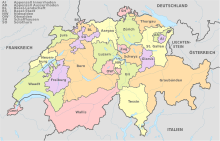
Swiss cantons

Ten-year government bond yields
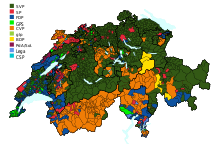
Strongest party per municipality (2019)
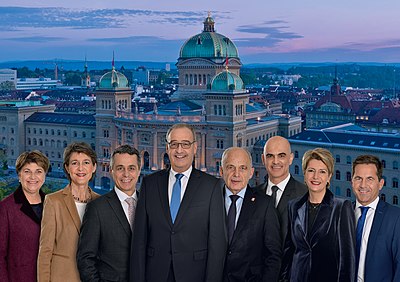
The Federal Council 2021: (from left to right) Viola Amherd, Simonetta Sommaruga, Ignazio Cassis, Guy Parmelin (President of the Confederation), Ueli Maurer, Alain Berset, Karin Keller-Sutter, Walter Thurnherr (Federal Chancellor)
Only these two cantons still practice the original Swiss grassroots democracy in this form.
.png)
Political system of Switzerland
Security
According to the Global Peace Index, Switzerland ranked 9th (out of 163 nations) in the world's safest countries in 2017.
Swiss army
→ Main articles: Swiss Army, Switzerland in the First World War and Switzerland in the Second World War.
The Swiss Army is the armed force of the Swiss Confederation. It consists of the Army and the Air Force. The annual budget is around 4.873 billion Swiss francs (2011).
The distinctive feature of the Swiss armed forces is their militia system. Professional and temporary military personnel make up only about 5 percent of the armed forces; all others are conscripted citizens between the ages of 20 and 34 (in special cases up to 50). Swiss citizens are prohibited from serving in a foreign army. The Vatican's Swiss Guard is exempt from this rule, as it is considered by Switzerland to be merely a security service.
Under the militia system, members of the armed forces keep their personal equipment, including personal weapons (until 2008 including pocket ammunition), at home. In connection with the peculiarities of the militia system, the formerly common saying "Switzerland has no army, Switzerland is an army" arose. Military service is compulsory for all male Swiss citizens. Women can volunteer for military service and since 2007 they are subject to the same physical requirements as men. Every year, about 20,000 people are trained as soldiers in recruit schools lasting 18 or 21 weeks. Those who are unfit for military service serve in civil defense and also pay an annual compulsory military service tax. Conscientious objectors to military service have the option of performing civilian service (→ Zivildienst in der Schweiz), provided they claim reasons of conscience and are willing to complete one and a half as many days of service as soldiers as proof of their actions. Conscientious objection for other (e.g. political or personal) reasons leads to compulsory military court proceedings.
With the reform "Army XXI" - adopted by referendum in 2003 - the number of troops envisaged in the previous "Army 95" concept will be reduced from 400,000 to about 200,000. Of these, 120,000 are assigned to active units and 80,000 to reserve units.
A total of three general mobilizations (GMob; also war mobilization, KMob) took place to protect the integrity and neutrality of Switzerland. The first GMob took place on the occasion of the Franco-Prussian War of 1870/71. In response to the outbreak of the First World War and in order to prevent a German or French march through Switzerland, a new GMob of the army was decided on August 3, 1914. The third GMob of the Army took place on September 1, 1939, in response to the German invasion of Poland. Henri Guisan was elected general and during the war years became the main integration figure of the Swiss Confederation, which was surrounded by the Axis powers.
Today's Switzerland has never faced open attacks by enemy forces on land since its founding in 1848. During World War II, however, airspace was frequently violated by German and Allied fighter planes. In the most serious attack, 40 people died in the bombing of Schaffhausen on April 1, 1944, and 270 were injured, some seriously (→ Allied bombing of Switzerland).
As the military threat situation in today's Europe has changed for Switzerland, the army is questioned again and again. The Group for a Switzerland without an Army (GSoA) in particular has been campaigning for abolition for years - but so far unsuccessfully: two referenda on abolishing the army were clearly rejected by the people. The question of whether peacekeeping operations abroad are compatible with neutrality is also controversial.
See also: Structure of the Swiss Army and List of Swiss Generals
Civil defense organization
→ Main article: Civil defense organization
Founded in 1934, the Civil Defense is subordinate to the Federal Department of Defense, Civil Protection and Sports. In the event of a disaster, it is responsible for the protection, care and support of the civilian population as the second echelon (after the fire department, police and health/rescue service, but before members of the armed forces). In addition, the civil defense takes care of the protection of cultural assets, supports the management bodies at communal and regional level and restores infrastructures.
Federal Intelligence Service NDB
→ Main article: Swiss intelligence services
The Swiss Intelligence Service (NIS), which has existed since January 1, 2010, resulted from the merger of the Service for Analysis and Prevention (DAP) and the Strategic Intelligence Service (SND). The FIS reports directly to the head of the Department of Defense, Civil Protection and Sport (DDPS). The intelligence service procures information by intelligence or secret service means and analyzes and evaluates it with the aim of producing a leadership-relevant intelligence situation for decision-makers at all levels. With its operational and preventive services, the FIS contributes directly to the protection of Switzerland.
Switzerland is likely to want to participate in the French Composante Spatiale Optique spy system, since it does not maintain its own satellites.
Border Guard Corps
→ Main article: Border Guard Corps
The Border Guard Corps (GWK) is responsible for protecting the Swiss border. The uniformed and armed border guards are part of the Federal Customs Administration, which is subordinate to the Federal Department of Finance. Border Guard Corps members are stationed at the border as well as at the airports of Zurich, Basel-Mulhouse, Geneva and Lugano-Agno; control the movement of people and goods; fight smuggling, cross-border crime, smuggling and trafficking in human beings.
See also: Swiss customs territory
Police
→ Main article: Police (Switzerland)
Police sovereignty in Switzerland lies with the cantons. For the enforcement of police power, each canton has its own cantonal police. In some cantons, basic police services are provided by city/community police forces, such as the Zurich city police. The respective cantonal police are also responsible for security at the airports located on their cantonal territory. The Federal Office of Police (fedpol) is responsible for coordination between the cantonal police forces as well as for the foreign police forces.
The general emergency number for the police in Switzerland is 117. Anyone dialing the European emergency number 112 is automatically connected to the operations center of the responsible cantonal police.
Fire department
→ Main article: Fire department in Switzerland
In most cantons, adult men and sometimes women are required to be firefighters. Organizing a fire department is primarily the responsibility of the municipalities. However, more and more local fire departments are being merged regionally. The fire department in Switzerland can be reached via the emergency number 118.
Air Rescue
→ Main article: Air rescue in Switzerland
Swiss Air-Rescue (Rega) is an independent and non-profit private foundation responsible for air rescue in Switzerland. It works closely with the blue-light organizations of the police, fire department and ambulance service. For alpine rescue and recovery operations, Rega is a close partner of the Swiss Alpine Club (SAC). In the canton ofValais, it is not Rega but Air-Glaciers and Air Zermatt that are responsible for air rescue. Rega can be reached in Switzerland via the emergency number 1414.
.jpg)
Super cougar
.jpg)
F/A-18 of the Swiss Air Force

Rega helicopter
Company
Social Policy
→ Main article: Social policy (Switzerland)
Switzerland is a very well-developed welfare state. There are several social insurances. These are compulsory insurances, which means that there is an insurance obligation for the residents. The most important social insurances are:
- the old-age and survivors' insurance (AHV), the state pension insurance
- the health insurance
- maternity insurance
- the accident insurance
- disability insurance (IV), for people who can no longer be fully employed due to disabilities or who require supplementary benefits
The state pension scheme (AHV), the occupational pension scheme (pension fund) and the private pension scheme are collectively referred to as the three-pillar system. For employed persons, an occupational pension plan, the pension fund, is mandatory. This is regulated by the private sector and is the responsibility of the employer. In contrast, private provision in the form of life insurance, for example, is voluntary. These are tax-subsidized up to a certain limit.
In addition, there is a compensation for loss of earnings scheme, so that persons liable for military service receive a daily allowance during the performance of military duties. Unemployment insurance is also mandatory.
See also: Social security (Switzerland)
Healthcare
→ Main article: Healthcare in Switzerland
In Switzerland, every resident - regardless of nationality - is required by the Health Insurance Act to take out insurance with a health insurance company of his or her choice to cover the costs of treatment in the event of illness ("basic insurance," "mandatory health care insurance"). In Switzerland, health insurance companies are exclusively private companies. They are legally obligated to include everyone in the basic insurance who submits a corresponding application, provided that he or she is resident in the area of activity of the health insurance fund. The payment of the premium (membership fee) is the responsibility of the insured person. It is a capitation premium, i.e. the premium is independent of income, but varies from health insurance company to health insurance company and from canton to canton. Low-income persons are granted individual premium reductions by the state. Public hospitals are financed on the one hand by revenues from treatment and on the other by subsidies from the cantons or municipalities. Private hospitals, on the other hand, are generally financed only by treatment fees, which are therefore significantly higher than those of state hospitals. For this reason, the statutory basic insurance does not cover treatment in private hospitals. Outpatient treatment, on the other hand, is covered by basic insurance throughout Switzerland and at any authorized health care provider. Dental treatment is not covered by health insurance, with a few exceptions. There are treaties with EU countries that regulate the mutual assumption of treatment in emergencies (form E111).
For treatment costs in case of accidents, every employee is compulsorily insured by the Accident Insurance Act (UVG). Most employees are also insured against loss of earnings, with the exception of non-occupational accidents for marginal employees, with a workload of less than 8 hours for an employee. On the one hand, there is an independent accident insurance company under public law (Swiss Accident Insurance Fund) (SUVA for short); on the other hand, most private insurance companies also offer accident insurance in accordance with UVG. The responsibility, whether SUVA or private insurance, depends on the economic sector of the employer and is regulated by the Federal Council in an ordinance. Sectors that are more prone to accidents, such as construction and forestry, are the responsibility of SUVA, for example. It is the employer's responsibility to insure all employees - including those who have accidents during their free time. Those who are not employed must insure themselves against treatment costs in the event of accidents.
| Development of life expectancy | |||
| Period | Years | Period | Years |
| 1950–1955 | 69,3 | 1985–1990 | 77,2 |
| 1955–1960 | 70,7 | 1990–1995 | 77,9 |
| 1960–1965 | 71,6 | 1995–2000 | 79,2 |
| 1965–1970 | 72,6 | 2000–2005 | 80,5 |
| 1970–1975 | 73,7 | 2005–2010 | 81,8 |
| 1975–1980 | 75,2 | 2010–2015 | 82,7 |
| 1980–1985 | 76,1 | 2015-2020 | 83,6 |
Source: UN
School system
→ Main article: Education system in Switzerland
The Swiss school system is a complex entity. The responsibility for the school system does not lie exclusively with the federal government, but is primarily a matter for the cantons due to federalism. In Switzerland, the average length of schooling for the population over 25 years of age was 13.4 years in 2015, the longest in the world.
The federal government and the cantons share responsibility for education, with the cantons having extensive autonomy. Defined at the federal level is the guarantee of free schooling, the start of a school year in August and the assurance of quality requirements. In other areas, the cantons have sole authority in compulsory education.
In secondary schools, the federal government has somewhat greater powers. However, the cantons are still responsible for implementation, and it is they who bear the responsibility.
At the tertiary level, competencies are also distributed. The Confederation is responsible for regulating the universities of applied sciences (UAS) and the two federal institutes of technology (ETH) in Zurich (ETHZ) and Lausanne (EPFL), as well as the Federal Institute of Sport in Magglingen. In the case of the universities, the responsibility lies with the cantons.
Based on these facts, one can speak of 26 different school systems in Switzerland according to the number of cantons.
The duration of elementary school, lower secondary school and the number of levels (performance level) in lower secondary school varies from canton to canton; the total is usually nine years. There are also large differences in the school material. The teaching materials (textbooks) are usually produced and distributed by the cantons themselves. After the end of compulsory education, however, they are all at a similar level. After compulsory schooling, students have the choice between a secondary school leading to the Matura or the start of vocational training, an apprenticeship. The apprenticeship is accompanied by regular attendance at a vocational school (→ Berufsfachschule in Switzerland). Voluntary attendance of a vocational secondary school (BMS) in parallel, which is completed with the vocational baccalaureate, is also possible. Most Swiss students choose the path of an apprenticeship. The BMS provides access to studies at a university of applied sciences. With the new so-called "Passerelle", after acquiring the vocational baccalaureate certificate (BM certificate), an additional year of schooling and an additional examination also provide access to a university without an examination.
See also: Swiss universities and universities of applied sciences
Human Rights
Switzerland is the depositary state of the Geneva Conventions. The intergovernmental agreement is an essential component of international humanitarian law.
In 1942, with the introduction of the Swiss Criminal Code, the death penalty was abolished in Switzerland in civil criminal proceedings. Since 1999, the death penalty has also been prohibited at the constitutional level.
In 1974, Switzerland ratified the European Convention on Human Rights.
Switzerland has a national human rights institution and a national commission for the prevention of torture. The commission visits places of deprivation of liberty. A referendum passed a constitutional amendment requiring foreign nationals convicted of certain crimes to be immediately deported to their home countries (see Federal Popular Initiative "For the Deportation of Criminal Foreigners (Deportation Initiative)"). Criminal law continued to contain no definition of torture recognized under international law.
Amnesty International has repeatedly criticized Switzerland's asylum policy. In 2010, the UN Committee Against Torture expressed concern that Switzerland's federal law on foreign nationals may violate the principle of non-refoulement (prohibition of deportation). The law allows for the automatic expulsion of foreign nationals deemed to be a security threat, without the individuals concerned being able to seek legal redress. That same year, the UN Committee on Economic, Social and Cultural Rights expressed concern that, in the face of inadequate facilities to accommodate asylum seekers, people were being housed indefinitely in underground civilian shelters.
As of February 2010, the Federal Administrative Court suspended the transfer of several asylum seekers to Greece under the Dublin II Regulation in order to await a landmark ruling on the admissibility of these transfers to Greece. The Federal Office for Migration FOM nevertheless deported a total of 50 asylum seekers to Greece in the course of 2010.
Orders and decorations
Switzerland and its cantons are considered to be one of the few states that do not award medals or decorations.
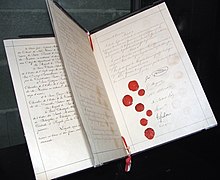
Original document of the first Geneva Convention, 1864

University Hospital Basel
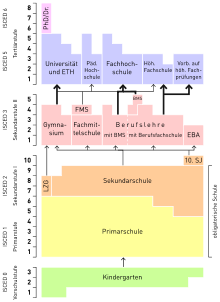
The Swiss education system (simplified representation)
Traffic
→ Main article: Transport in Switzerland
Rail transport
Switzerland has the densest railroad network in the world, with about 122 meters per square kilometer (excluding micro-states such as the Vatican City State or Monaco), although two-thirds of the country is located in very mountainous terrain and does not contribute at all to this record. The Swiss standard gauge railroad network is 3778 km and is completely electrified. The narrow-gauge, meter-gauge, and broad-gauge railroads have a combined length of 1766 km, of which 30 km (1.7 percent) are not electrified. Electrification has been 80 percent AC (alternating and three-phase current) and 20 percent DC (direct current).
With a distance of 3236 km, the Swiss Federal Railways (SBB) operate the most railroad lines. They alone carry over 300 million passengers annually. The second longest network, with just 420 km of track, is operated by BLS AG, followed immediately by the meter-gauge Rhaetian Railway with 384 km, whose lines are located exclusively in the canton of Graubünden. In addition, there are another 47 private railway companies in Switzerland. In Switzerland, private railroads are those railroad companies that are organized under private law, i.e. as a rule as stock corporations under the Swiss Code of Obligations. In most cases, the main shareholders are public authorities. The public sector also plays an important role in financing rail transport. In 2016, the federal government, cantons and municipalities paid around CHF 5.1 billion (45%) of the total costs.
In 2019, every Swiss person made an average of 74 rail journeys, covering a distance of 2505 km, making Switzerland the world's leading rail traveler nation.
As part of the New Rail Link through the Alps (NRLA), the Gotthard and Lötschberg base tunnels were built to serve the constitutionally mandated transfer of transit traffic. The Lötschberg base tunnel went into operation for regular passenger and freight traffic with the timetable change on December 9, 2007; the Gotthard base tunnel, with 57 km the longest tunnel in the world, followed on December 11, 2016.
Since 1990, several suburban railroads (→ S-Bahns in Switzerland) have been established, which now handle a large proportion of local rail traffic. In order to keep fares as simple as possible, nationwide tariff associations have been established.
International long-distance passenger rail services are to be promoted more strongly again. To this end, the transport ministers of Germany, France, Austria and Switzerland made a decision in principle in December 2020 and the four state railroads SBB, DB, ÖBB and SNCF signed a corresponding declaration of intent.
See also: Rail transport in Switzerland, History of Swiss railroads and List of Swiss railroad companies
Local traffic
As a supplement to the very dense rail network, buses, streetcars and light rail provide the fine-grained local public transport.
Bus: Several dozen regional transport companies carry passengers in the cities and in the countryside. There is hardly a place that is not connected to public transport; even the village of Juf (Canton of Graubünden), the highest settlement in Europe, is served daily by public transport. In the larger cities, electrically powered trolley buses are also used. The yellow Postbus forms the backbone of public transport in many rural and mountain areas.
See also: List of trolleybus systems (Switzerland section)
Streetcar: Until the 1960s, streetcars (streetcars) ran in many cities and agglomerations. The growing road traffic needed more space and so in many places the streetcars were replaced by buses. In the six cities of Basel, Bern, Geneva, Neuchâtel, Lausanne and Zurich, many streetcar lines still exist today.
See also: List of cities with tramways (Switzerland section)
Light rail: To complement commuter trains, buses and streetcars, several light rail systems have been built in recent years or are still in the planning stage. The most recent light rail system is the Glattalbahn near Zurich.
Subway: Apart from the Skymetro at Zurich Airport, the Métro Lausanne is the only urban subway in Switzerland.
Road traffic
The majority of the population in the densely populated Central Plateau lives less than 10 km from the nearest highway or freeway. By contrast, a large area of Switzerland with a relatively small population is served by main roads, and finally, in the mountains, there are various connections via mountain passes (→ List of mountain passes in Switzerland) and through tunnels (→ List of Swiss tunnels), most of which are closed in winter. In 2017, the total length of all roads was 71,557 km, of which 1458 km were highways. In 2020, more than one million people were affected by excessive road traffic noise. The public sector pays billions of francs every year to pay for the costs of externalities. In 2017, these costs were 9.5 billion francs, representing 71% of the total external costs of transport in Switzerland. In principle, these costs should be charged to motorists.
The well-developed public transport network is noticeable in that around one fifth of all Swiss households do not have their own car. This proportion rises to as much as 57 percent in the cities, additionally supported by the fact that car sharing is also widespread in Switzerland. In the canton of Graubünden, individual motor vehicle traffic remained prohibited until 1926. Tire wear releases several thousand tons of microplastics into the environment. As more and also larger cars are in use, the energy efficiency of road traffic is constantly decreasing. In 2018, a quarter of Switzerland's total energy consumption was used in road transport and the average CO2 values of new cars were the highest in Europe. In 2019, there were 187 traffic fatalities on Swiss roads, the lowest level since 1940. In the same year, the motorization rate (passenger cars per 1000 inhabitants) was 541 and CO2 emissions from new cars continued to increase. Through alternative drives and fuels, etc., road traffic should once again become more energy-efficient and climate-friendly. In 2019, 13,197 all-electric cars were registered, more than twice as many as in the previous year (+143.9%). However, because more were driven in the same year (with the motorized vehicle population of 6,160,300), CO2 emissions did not decrease. In 2020, the year of the Corona economic crisis, 236,828 new passenger cars were registered, the lowest number since the oil crisis of the mid-1970s. Yet the road vehicle population has continued to expand. Commuters can claim a tax deduction for their commute to work.
The use of the Swiss road network is basically free of charge for passenger cars. However, for the use of the freeways with white-green signs, there is a compulsory vignette for passenger cars in Switzerland, the national road tax (CHF 40), which has to be paid once for one year. Charges on a private road open to the public are the absolute exception (best-known example: the tunnel leading to Italy at the Great St. Bernhard).
Since January 1, 2001, trucks have been subject to the performance-based heavy vehicle fee (HVF), which is levied electronically and whose amount depends not on the type of road traveled, but on the distance driven and the vehicle's emission category. On February 28, 2016, a referendum approved the construction of a second tube of the Gotthard road tunnel with a yes vote of 57 percent. The new tunnel tube is needed because of the renovation of the old Gotthard road tunnel (→ Federal referendum on the renovation of the Gotthard road tunnel).
See also: Road system in Switzerland and Liechtenstein, List of freeways and freeways in Switzerland and Licence plate (Switzerland)
Air traffic
Switzerland has three national airports, eleven regional airfields, 44 airfields and five military airfields in civilian use. The largest airports and departure points for long-haul flights are located at Kloten (Zurich Airport) and Cointrin (Geneva Airport). The third largest airport in Switzerland, Basel-Mulhouse Airport, is located in Hésingue and Saint-Louis on French soil. Regional airfields are also located in Sion (Sion Airport), Bern-Belp (Bern-Belp Airport), Lugano-Agno (Lugano-Agno Airport) and St. Gallen-Altenrhein (St. Gallen-Altenrhein Airport). One of the highest airfields in Europe, Engadin Airport, is located near Samedan.
According to Greenpeace, air traffic in Switzerland is subsidized to the tune of 1.7 billion Swiss francs annually, as airlines forgo the mineral oil tax (see also kerosene tax). In addition, the environmental and health costs from air traffic of around 1.2 billion Swiss francs in 2016 were almost entirely borne by the general public. In 2017, the cost of these externalities was 1.4 billion Swiss francs, representing 10% of the total external costs of transport in Switzerland. In 2018, 77% of the destinations from Switzerland were in Europe.
Until its debt restructuring in October 2001, Swissair was a national airline and operated a global route network and the regional airline Crossair. Its successor, Swiss, has been a subsidiary of Deutsche Lufthansa AG since July 2007 and continues to operate intercontinental routes. Other Swiss airlines include Edelweiss Air and Helvetic Airways.
The only domestic flight connection is the Zurich-Geneva route offered by Swiss.
Skyguide, a public limited company under private law, is responsible for air traffic control in Swiss airspace and in the adjacent airspace of Germany, Austria, France and Italy on behalf of the Federal Office of Civil Aviation (FOCA). In Swiss airspace, this includes both civil and military air traffic control.
The Federal Air Transport Service, which is also responsible for the Federal Council's two jets, is stationed at Bern-Belp Airport.
In aircraft registration plates the sovereign sign of Switzerland is HB, Swiss airfields get ICAO codes starting with LS.
See also: List of airports in Switzerland and List of aviation accidents (Switzerland)
Shipping
The only international ports with a sea connection are the Swiss Rhine ports, which are located in and near Basel on the Rhine. Four shipping companies operate a total of 19 ocean-going vessels (as of 2020) under the Swiss flag (→ Swiss ocean shipping).
In addition, there are the ports of the inland lakes, which, along with the ferry operations across Lake Zurich, Lake Constance and Lake Lucerne, and the development of the community of Quinten on Lake Walen, have a high tourist content.
The only freight traffic on the lakes is usually gravel transport by leather ships. Excursion boats operate on most of the larger lakes and rivers, sometimes only in the summer months. Particularly popular with passengers are the restored and listed paddle steamers.
See also: List of Swiss shipping companies and List of ferry routes in Switzerland.
Mountain railroads
Due to the topography, there are many mountain railroads, funicular railroads and aerial tramways in Switzerland, some of which serve as public transport for the development of settlements and others for tourism. The railroad station on the Jungfraujoch is the highest station in Europe and the aerial cableway to the Kleine Matterhorn is the highest railroad station in Europe.
Some places in the Swiss mountain area are not or only partially accessible by road due to their location. The places and vacation settlements in Switzerland that can only be reached by rail or cable car include Belalp, Bettmeralp, Braunwald, Fiescheralp, Gimmelwald, Gspon, Landarenca, Lauchernalp, Mürren, Niederrickenbach, Rasa, Riederalp, Schatzalp, Stoos, Wengen, Wirzweli and Zermatt. For those arriving by car, parking spaces or even parking garages are available at the last railroad station accessible by car or at the valley station, for example for Mürren and Wengen in Lauterbrunnen, for Zermatt in Täsch.
See also: List of mountain railroads in Switzerland
Slow traffic
SwitzerlandMobility is the national network for non-motorized traffic, especially for leisure and tourism. Slow-moving traffic is the official generic term in Switzerland for walking, cycling, mountain biking, skating and canoeing. The project was launched in 1998 and consists of several parts. The Veloland Schweiz foundation promotes recreational cycling in Switzerland and created nine national routes by 1998. Other themes are Mountainbikeland Schweiz, Skatingland Schweiz and Kanuland Schweiz.
Under the name Hiking in Switzerland, hiking trails are also part of the SwitzerlandMobility project. Switzerland has a network of uniformly marked hiking trails with a total length of 62,441 km, of which 13,880 km are hard-surfaced and 23,090 km are mountain trails (as of 2007). A distinction is made between three types of hiking trails with different levels of difficulty: yellow-marked hiking trails, white-red-white-marked mountain trails and the white-blue-white-marked alpine routes. In 2017, SwitzerlandMobility was supplemented by a uniformly signalized winter offering for winter hiking, snowshoeing, cross-country skiing and sledding.
In the modal split, 37 percent of all trips, or 6 percent of all person-kilometers, were made by non-motorized transport in 2015.

Biogas-powered articulated bus in Bern's Old Town

Switzerland's expressway network
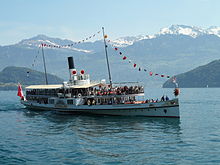
DS Unterwalden on Lake Lucerne
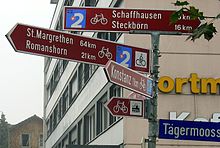
Signalization of the bicycle routes in Veloland Switzerland

ABe 8-12 Allegra of the Rhaetian Railway on the Bernina line
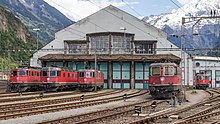
Locomotive shed Erstfeld

The railroad network in Switzerland
Economy
→ Main article: Swiss economy and Swissness
Switzerland is one of the wealthiest countries in the world. In terms of gross domestic product, Switzerland ranked 20th in 2019 with the equivalent of 705 billion US dollars, and second in terms of gross domestic product per capita with 82,484 US dollars. According to a study by the bank Credit Suisse, residents of Switzerland have the second highest per capita wealth in the world at 537,599 U.S. dollars (as of 2017), and one in ten adults has assets of more than one million dollars.
In 2020, 5.0 million people were employed in Switzerland. 2.8 percent worked in agriculture (primary sector), 20.8 percent in industry and trade (secondary sector) and 76.4 percent in the service sector (tertiary sector). As of January 31, 2021, the unemployment rate was 3.7 percent. The general price level is high. The cost of living is the highest in Europe and was 63.3 percent higher than the EU average in 2015. Zurich and Geneva were considered the most expensive cities in the world in 2016.
Switzerland's economy is considered one of the most stable economies in the world. One of the factors behind its success is price stability. In 2008, for example, annual inflation of 2.4 percent was above a level of 1.8 percent for the first time since 1994. Economic freedom is guaranteed by Article 27 of the Swiss Federal Constitution and by all 26 cantonal constitutions. In 2020, Switzerland ranked 5th on the economic freedom index. In the World Economic Forum's Global Competitiveness Report 2017-2018, which measures the competitiveness of countries, Switzerland ranked first, ahead of Singapore and the United States. Switzerland ranks first on the Global Innovation Index, which represents the innovative capacity of individual countries.
According to Brand Finance, the five most valuable brands (and companies) from Switzerland are: Nestlé, UBS, Zurich, Rolex and Roche. Economiesuisse is the largest umbrella organization of the Swiss economy (→ List of business associations in Switzerland). The Swiss Federation of Trade Unions is the largest trade union in the country (→ List of trade unions in Switzerland).
See also: List of the largest companies in Switzerland and List of listed Swiss companies
Swiss franc
→ Main article: Swiss franc
· Current banknotes of the Swiss franc
· 
CHF 10
· 
CHF 20
· 
CHF 50
· 
CHF 100
· 
CHF 200
· 
CHF 1000
The Swiss franc (abbreviated Fr. , SFr. and CHF) is the official currency of Switzerland. After the US dollar, euro, pound and yen, the Swiss franc is one of the most important minor currencies in the world.
As an independent central bank, the Swiss National Bank SNB conducts the monetary and foreign exchange policy of the Swiss Confederation and held currency reserves of CHF 477.4 billion and gold holdings of CHF 35.6 billion in 2013. Banknotes in circulation amounted to CHF 65.8 billion. By February 2018, foreign exchange reserves had risen to $826 billion (CHF 779 billion), making the country the third-highest holder of foreign exchange reserves behind the People's Republic of China and Japan.
Agriculture
→ Main article: History of agriculture in Switzerland
The small-scale structures, the partly unfavorable terrain, the high wage level and the strict regulations (animal husbandry, landscape protection) have a negative impact on international competitiveness. With the increasing opening of the agricultural market, Swiss agriculture is coming under pressure. The structural change from many small farms in mountain and pre-Alpine regions to a few large farms in the flat Central Plateau has continued for decades. Between 2000 and 2011, the number of full-time employees in agriculture declined by 23,280 and amounted to only 72,715 (-24 percent) in 2011. The number of farms also declined by 1.8 percent, while farmland barely decreased. Agriculture is supported by the federal government with considerable funds (subsidies or conditional direct payments). The gross degree of self-sufficiency has been below 60 percent in recent years. The net degree of self-sufficiency (including imported feedstuffs) was 48 percent in 2016.
Raw materials and energy production
→ Main article: Swiss energy policy and electricity industry in Switzerland
Ecological resources in Switzerland are scarce. The biocapacity respectively the biological natural capital per capita is 40% smaller than the world average: In 2016, Switzerland had 1.0 global hectares of biocapacity per person compared to the world average of 1.6 global hectares per person. In contrast, Switzerland's use of biocapacity and thus its consumption-related ecological footprint was 4.6 hectares per capita. With about 4.6 times more biocapacity used than Switzerland contains, the densely populated country has a substantial biocapacity deficit.
In Switzerland, which is poor in raw materials, gravel, lime (→ Netstal lime factory), clay, granite and salt (→ Swiss salt works) are mined.
Around 5 million tons of cement are consumed annually in Switzerland, 86 percent of which was covered by the six Swiss cement plants in 2019 and 14 percent by imports. The six cement plants are located at Eclépens, Cornaux, Péry, Wildegg, Siggenthal-Station and Untervaz. In addition to using coal, heavy oil, petroleum coke and natural gas, they also recycle plastic waste, solvents, sewage sludge, meat-and-bone meal, animal fats and almost half of all used tires produced in Switzerland. Vigier Cement Ltd, based in Péry, alone emitted over 475 thousand tons of carbon dioxide (CO2) into the air in 2018. In addition, during the same period, there were about 2054 tons of carbon monoxide, about 508 tons of nitrogen oxides, about 30 tons of ammonia (NH3), almost 3.8 tons of benzene and 40 kg of mercury.
The Swiss oil refinery in Cressier is directly connected to the Southern European Pipeline. In 2014, oil accounted for 51.5 percent of Swiss energy consumption.
Swissgas, the Swiss natural gas trading and transport company, procures and transports natural gas on behalf of the four Swiss regional gas distribution companies. 12 entry points are connected to the European gas pipeline network. The most important feed line is the Trans-Europe Natural Gas Pipeline, which runs from the Netherlands to Italy. In 2012, 41 percent of the natural gas consumed in Switzerland came from the EU, 24 percent from Norway and 21 percent from Russia. The remaining 12 percent came from other countries. In 2015, gas accounted for 13.5% of total final energy consumption.
Hydropower is an important resource in Switzerland; the more than 500 larger and smaller storage power plants and run-of-river power plants cover around two-thirds of Switzerland's electricity requirements (→ List of storage lakes in Switzerland). In 2016, the Swiss Federal Institute for Forest, Snow and Landscape Research counted 249 energy cooperatives based on commercial register entries, which trade and promote renewable energies in particular. In addition, there are 30 waste incineration plants (KVA) which can expect above-average waste volumes due to consumer behavior and population growth. According to Eurostat, 703 kilograms of municipal waste per capita were generated in 2017, of which 336 kilograms were incinerated. A nationwide recycling of beverage cartons for the recovery of secondary raw materials was discontinued again because not all retailers wanted to participate in the collection.
Nuclear energy contributes 39 percent to domestic electricity production on a ten-year average, and up to 45 percent in winter. Swiss nuclear power plants, with four reactor units at three locations, have a total capacity of 3.095 gigawatts; their annual availability is around 90 percent (→ Nuclear energy in Switzerland). On May 21, 2017, the Swiss population voted in favor of the Energy Strategy 2050 with 58.2% in favor. As a result, the construction of new nuclear power plants is prohibited. Furthermore, renewable energies (including with the feed-in tariff) and the more efficient use of energy are to be promoted.
In Switzerland, a good five million cubic meters of wood are harvested each year, which corresponds to about two-thirds of the usable wood that grows in the Swiss forest each year. Switzerland imports more wood and wood products than it exports. Each year, a good six million cubic meters of wood are used for energy, consumed as cardboard or paper, made into furniture or used in construction. Meanwhile, more virtual water is imported than exported. The bottom line is that every day the volume of Lake Thun is used. Around 82 percent of Switzerland's water footprint is generated outside the country. If everyone lived as they do in Switzerland, it would take three Earths, otherwise the world's resources would already be exhausted on May 11 (as of 2021). The consumption of fossil energy, which has increased sharply in recent decades, accounts for almost three quarters of Switzerland's ecological footprint.
Trade and industry
Most of the gross domestic product is generated in the secondary and tertiary sectors. The share of value added in the industrial sector in total gross domestic product has declined since 1970 from around 30 percent to around 22 percent today. The greatest decline occurred in the years between 1973 and 1979, when the share fell by about 6 percentage points to less than 24 percent. The formerly dominant textile industry has largely disappeared (→ Textile industry in eastern Switzerland).
Small and medium-sized enterprises (SMEs for short; companies with up to 249 employees) are of crucial importance in the Swiss economy. More than 99 percent of all companies are SMEs. They provide two-thirds of all jobs.
Major international companies play an important role in the machinery industry, such as ABB; in the food industry, such as Nestlé, Lindt & Sprüngli (→ Swiss chocolate) and Givaudan; in the pharmaceutical industry, with Novartis and Roche; in the chemical industry, with Syngenta; and in the watch and luxury goods industry, with Swatch Group and Richemont.
In 2008, Switzerland drew level with Germany in terms of its industrial share of value added, overtaking Japan. This is mainly due to the fact that industry produces very high-value goods such as medical technology products, pharmaceuticals, precision instruments or luxury watches. In absolute terms, Switzerland's industrial output of around 100 billion US dollars is significantly greater than that of Belgium, Norway or Sweden and is roughly on a par with that of Taiwan and the Netherlands. Converted to a per capita share, Switzerland leads the world with around 12,400 US dollars, ahead of Japan with 8,600 US dollars and Germany with 7,700 US dollars.
Some of the federally owned defense companies were merged into RUAG in 1998.
Of the 1,035,000 people employed in industry and commerce in 2013, 31.7% worked in construction, 10.4% in watchmaking and precision instruments, 9.6% in metalworking, 9.5% in machinery and vehicle manufacturing, 6.8% in chemicals, 6.4% in food, beverages and tobacco, 1.4% in textiles, and 24.2% in other industry.
Services
The tertiary sector has by far the largest workforce (72 percent). The dominant sectors are trade, healthcare and education, as well as banking (→ Swiss banking) and insurance, including UBS, Credit Suisse, Zurich, Swiss Life and Swiss Re, as well as the legal profession, whereby lawyers often also act as financial intermediaries. In the years after 2000, companies from the commodities trading sector settled here: Vitol, Glencore, Xstrata, Mercuria Energy Group.
Tourism
→ Main article: Tourism in Switzerland
Tourism has been an important industry in Switzerland for about 150 years. It has been favored by the Alps, the many lakes, the central location in Europe, stable politics, a secure society and a strong economy. The most popular destinations and most visited regions include Zurich, Lucerne, Grisons, Bernese Oberland, Valais, Geneva, Vaud, Basel, Ticino, Eastern Switzerland and Bern. In 2013, there were a total of 5129 hotels and spa establishments in Switzerland with 249,666 beds and over 25,000 classified vacation apartments and guest rooms. There are also 755 group accommodations, 52 youth hostels, 412 campgrounds, over 1000 bed-and-breakfast establishments, 29,000 train stations and 2500 cable cars. 210,000 of Switzerland's employees (4 percent) in 167,590 full-time positions worked in tourism. In 2012, 34.8 million overnight hotel stays were recorded. Tourism (foreign guests only) ranked fourth in terms of export revenue in 2012 with 16 billion Swiss francs (4.6 percent). Especially in the economically weaker mountain regions, tourism is a significant economic factor. In the mountain cantons of Graubünden and Valais, it accounts for up to 30 percent of gross domestic product (GDP), while the figure for Switzerland as a whole is 2.6 percent.
See also: List of ski resorts in Switzerland and List of observation towers in Switzerland
Retail trade
The Swiss retail trade (retail trade) is dominated by the two cooperatively organized retail giants Migros and Coop. The two German retail chains Aldi and Lidl entered the Swiss market in 2005 and 2009 respectively. They are currently in the process of establishing a nationwide network of stores. The largest shopping center in the country is the Glattzentrum.
Foreign trade
The following table shows Switzerland's ten most important trading partners for exports and imports of goods (as of 2019). The pharmaceutical and chemical industries account for a particularly large share of exports, amounting to 44.9 percent in 2016.
| Main trading partners (2019) | |||
| Export/export to | Total in millions ofSwiss | Import/import of | Total in millions ofSwiss |
| Germany | 47'685 | Germany | 57'191 |
| United States | 44'213 | Italy | 22'235 |
| United Kingdom | 28'143 | France | 18'919 |
| China | 21'437 | United States | 18'883 |
| France | 19'237 | United Kingdom | 16'411 |
| India | 17'947 | China People's Republic of | 15'051 |
| Italy | 16'063 | United Arab Emirates | 14'948 |
| Hong Kong | 9'909 | Austria | 8'453 |
| Japan Japan | 8'136 | Ireland | 7'544 |
| Spain | 7'825 | Spain | 6'414 |
| Development of foreign trade (in billions of Swiss francs) | ||||||
| 2015 | 2016 | 2017 | 2018 | 2019 | 2020 | |
| Import | 243,8 | 266,1 | 265,6 | 273,4 | 276,1 | 182,1 |
| Export | 279,2 | 298,4 | 294,9 | 303,9 | 312,0 | 225,1 |
| Balance | 35,4 | 32,3 | 29,3 | 30,5 | 37,3 | 43,0 |
Switzerland is a member of the International Cocoa Organization (ICCO) and the International Sugar Organization (ISO).
Trade fairs
Important international and national trade fairs are held in Switzerland every year. The most important fairs are:
- Art Basel, one of the world's most important art fairs
- Geneva Motor Show, one of the world's most important automotive trade fair in Le Grand-Saconnex
- International Exhibition of Inventions in Geneva
- OLMA, Swiss Exhibition for Agriculture and Food in St. Gallen
- BEA, Exhibition for Trade, Agriculture and Industry in Bern
Former trade fairs:
- Baselworld, the world's most important trade fair for the watch and jewelry industry
- MUBA, sample fair in Basel
- Züspa, autumn fair in Zurich

The Roche Tower in Basel. The pharmaceutical company Hoffmann-La Roche is one of the most important in the world.
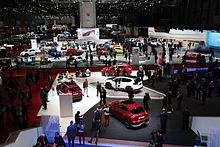
Geneva Motor Show at the Palexpo Halls in Le Grand-Saconnex (GE)

Paradeplatz in Zurich with Credit Suisse and UBS

The Contra dam on Lago di Vogorno
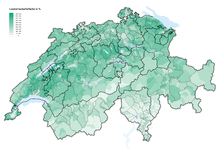
Agricultural land per municipality (2016)
Media, communication and mail
→ Main article: Media in Switzerland
Press
Supraregional newspapers are the internationally respected Neue Zürcher Zeitung (NZZ) and the Tages-Anzeiger, Basler Zeitung and Der Bund, which are linked through their editorial offices. The most widely read daily newspaper is the free commuter paper 20 Minuten (20 minutes in French), ahead of the tabloid Blick and the Tages-Anzeiger. Other newspapers have a regional focus. In Romandie (French-speaking Switzerland), Le Temps is a national daily. A regional daily in French-speaking Switzerland is 24 heures.
Well-known news magazines are the weekly formats Die Weltwoche and Die Wochenzeitung. Well-known French-language magazines are L'Hebdo and L'illustré.
In 2018, a "media quality ranking" by media scientists at the Universities of Zurich and Fribourg mentioned the NZZ, Le Temps and the Bund in the leading position.
See also: List of Swiss newspapers
Radio and television
Alongside numerous private providers, the Swiss Broadcasting Corporation SRG SSR is by far the most important and largest provider of radio and television programming in Switzerland.
See also: List of Swiss television presenters
SRG SSR
The Swiss Broadcasting Corporation SRG SSR is a private association with a public service remit based in Berne and is the owner of the country's largest electronic media enterprise. SRG's activities are based on the Swiss Federal Constitution, the Radio and Television Act, the Radio and Television Ordinance and the federal concession, which entrust it with a wide range of tasks in the service of the general public (public service). SRG SSR is both journalistically and organizationally independent. Through its enterprise units
- Swiss Radio and Television (SRF)
- Radio Télévision Suisse (RTS)
- Radiotelevisione Svizzera (RSI)
- Radiotelevisiun Svizra Rumantscha (RTR)
SRG SSR is present in all language regions with its radio and television stations.
Radio
The public SRG SSR operates six radio stations in German (Radio SRF 1, Radio SRF 2 Kultur, Radio SRF 3, Radio SRF 4 News, Radio SRF Virus and Radio SRF Musikwelle). There are also four stations in French (La Première, Espace 2, Couleur 3 and Option Musique), three in Italian (Rete Uno, Rete Due, Rete Tre), and one in Romansh (Radio Rumantsch). SRG SSR also operates the special-interest stations Radio Swiss Pop, Radio Swiss Classic and Radio Swiss Jazz. The radio stations are financed by radio license fees. SRG SSR is not permitted to advertise on the radio.
Private, commercial radio stations have been operating in all regions since 1983. In addition, there is a large group of non-commercial regional stations that produce complementary programs away from the standard brew. They have joined forces in the Union of Non-Commercial Local Radio Stations (UNIKOM) group.
All SRG radio stations, as well as many private radio stations, are broadcast not only via FM but also via DAB+ (→ Digital Audio Broadcasting in Switzerland).
See also: History of radio in Switzerland, List of radio stations in Switzerland and Country stations in Switzerland.
Television
SRG SSR's public television service includes six channels with full programming, two for each of the three major language regions (German-speaking Switzerland SRF 1 and SRF zwei, French-speaking Switzerland RTS Un and RTS Deux, Italian-speaking Switzerland RSI LA 1 and RSI LA 2). SRF also produces the news and repeat channel SRF info, which can be received unencrypted via satellite throughout Europe. All seven TV channels are produced in HDTV quality (720p) and can be received via the Hotbird satellite. The French-language RTS Info can be received as a live stream throughout the world.
To promote the Rhaeto-Romanic language, short programs with German subtitles from Televisiun Rumantscha are broadcast daily on SRF 1.
SRG SSR's television programs are financed by broadcasting fees and advertising.
Private stations with a national broadcast area include 3+, 4+, 5+, Star TV, Puls 8, S1, TV24 and TV25. In addition, there are many local stations. Many German stations such as RTL, RTL II, VOX, Sat.1, kabel eins and ProSieben broadcast their programs in German-speaking Switzerland with special advertising windows and a few programs produced specifically for Switzerland. With the exception of local programs, almost all German and Austrian channels as well as French and Italian channels can be received in Switzerland.
See also: List of television transmitters (Switzerland section) and List of the highest television and telecommunications towers in Switzerland.
Foreign Service
Swissinfo.ch is the name of Switzerland's multimedia foreign service produced by SRG in 10 languages. The Internet platform replaced the outdated medium-wave service Schweizer Radio International in 1999 and is financially supported by the federal government.
Communication and mail
The three network providers Swisscom, Sunrise Communications and Salt Mobile each operate their own nationwide mobile communications network. The then state telephone monopolist PTT (predecessor of Swisscom and Die Post) put the analog NATEL A network into operation in 1978. The NATEL B network followed in 1983 and the NATEL C network in 1987. Since the data volumes transferred are constantly increasing, the mobile network has already been expanded several times, currently to 5G. The state monopoly was abolished in 1998. The word Natel is an abbreviation for "national car phone" and is still used in Switzerland as a synonym for mobile communications. The Swiss government held 51.22 percent of Swisscom AG at the end of 2013.
In 2016, 87.2% of the population used the Internet.
Swiss Post Ltd. is the state-owned postal company in Switzerland.
See also: postal history and stamps of Switzerland, postal code, Swiss mobile phone market, telephone area code and public service.
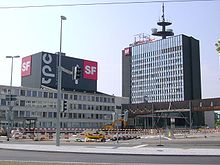
View of the building complex of Swiss Television (SRF) in Zurich

First edition of the Neue Zürcher Zeitung of January 12, 1780
International organizations
Because of its neutrality, political stability as well as its humanitarian tradition, Switzerland is the seat of many international organizations, associations and non-governmental organizations from politics, sports, science and culture. Particularly many of them are based in Geneva, probably the country's best-connected city in diplomatic terms.
- Geneva:
See also: List of international organizations in Geneva
·
- Geneva is home to the United Nations Office at Geneva (UNOG), one of the four permanent seats of the United Nations (UN), along with New York, Vienna and Nairobi. Geneva is also the headquarters of several UN specialized agencies and UN subsidiary bodies. With more than 2700 conferences and meetings a year, attended by some 200,000 delegates from around the world, Geneva is the world's most active center of multilateral diplomacy. In addition, Geneva hosts some 250 non-governmental organizations with consultative status at the United Nations. Geneva was already the headquarters of the UN's predecessor organization, the League of Nations, in the interwar period.
- World Trade Organization (WTO)
- United Nations Conference on Trade and Development (UNCTAD)
- International Labor Organization (ILO)
- World Health Organization (WHO)
- United Nations High Commissioner for Refugees (UNHCR)
- International Organization for Standardization (ISO)
- International Electrotechnical Commission (IEC)
- International Telecommunication Union (ITU)
- World Meteorological Organization (WMO)
- World Intellectual Property Organization (WIPO)
- European Broadcasting Union (EBU)
- International Committee of the Red Cross (ICRC) and International Federation of National Red Cross and Red Crescent Societies (IFRC), see International Red Cross and Red Crescent Movement.
- European Organization for Nuclear Research (CERN)
- World Scout Organization (WOSM)
- World Council of Churches (WCC)
- Lutheran World Federation (LWF)
- World Association for Investment Promotion Agencies (WAIPA)
- International Organization for Migration (IOM)
- Basel:
- Bank for International Settlements (BIS)
- Eurofima
- International Handball Federation
- Lausanne occupies a special position in the sports world as the seat of the International Olympic Committee (CIO) and the International Court of Justice for Sport (CAS). It is considered the "Olympic Capital".
- International Skating Union (ISU)
- Zurich:
- Fédération Internationale de Football Association (FIFA)
- International Ice Hockey Federation (IIHF)
- Aigle:
- Union Cycliste Internationale (UCI)
- Bern:
- Universal Postal Union (UPU)
- Cologny:
- World Economic Forum (WEF)
- Gland
- International Union for Conservation of Nature (IUCN), World Conservation Union
- World Wide Fund For Nature (WWF)
- Nyon:
- Union des Associations Européennes de Football (UEFA)
- Oberhofen on Lake Thun:
- Fédération Internationale de Ski (FIS)
See also: World sports federations based in Switzerland

FIFA headquarters in Zurich
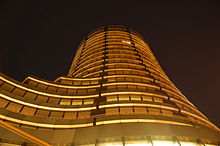
Global headquarters of the Bank for International Settlements (BIS) in Basel
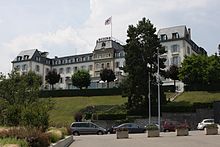
The headquarters of the International Committee of the Red Cross (ICRC) in Geneva
Science
The first university in Switzerland was founded in Basel in 1460. The work of the physician and mystic Paracelsus (Theophrastus Bombastus von Hohenheim) deserves special mention. The long tradition of chemical and medical research in Switzerland goes back to him. On the other hand, Erasmus of Rotterdam's work at the University of Basel from 1515 onwards made the university and at the same time the city one of the most important centers of knowledge during the Renaissance north of the Alps. Other research priorities for the future include nanotechnology, computer science, space research and climate research. The importance of science for Switzerland results especially from the fact that Switzerland is a country poor in raw materials.
Numerous Nobel Prize winners, such as the physicist Albert Einstein, conducted research in Switzerland. One international research site is the European Organization for Nuclear Research (CERN) in Meyrin in the canton of Geneva.
The two technical universities ETH in Zurich and EPF in Lausanne are assigned to the Federal Department of Home Affairs (FDHA) but are not subordinate to it. Affiliated to the technical universities via the ETH Domain are the Paul Scherrer Institute (PSI), the Swiss Federal Laboratories for Materials Testing and Research (Empa), the Swiss Federal Institute for Forest, Snow and Landscape Research (WSL) and Eawag, which conducts research on water. Affiliated to the FDHA are Swissmedic and the National Museum. Via the Federal Office of Culture (FOC), the Swiss National Library is subordinate to the FDHA.
Within the Federal Department of Economic Affairs, Education and Research (EAER), the Federal Veterinary Office (FVO) operates the Institute of Virology and Immunology (IVI). The Federal Office for Agriculture (FOAG) operates the three Agroscope research institutes.
The Federal Department of Defense, Civil Protection and Sport (DDPS) operates the Spiez laboratory through the Federal Office for Civil Protection (FOCP).
Most other universities and universities of applied sciences are run by the cantons, and some universities of applied sciences are run privately. The Swiss University Conference ensures coordination between the federal government and the cantons. The Rectors' Conference of the Swiss Universities represents the interests of the universities vis-à-vis the cantonal and federal authorities.
In Switzerland, various institutions and foundations exist to promote scientific research. Of particular note is the Swiss National Science Foundation (SNSF).
Switzerland is a member and founding state of the European Space Agency (ESA). Swiss astronaut Claude Nicollier flew four times into space on four different space shuttles as part of a cooperation program between ESA and NASA.
See also: List of Swiss Nobel Laureates and List of Swiss Inventors and Discoverers
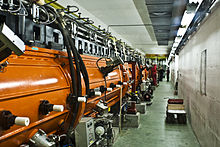
Linear accelerator at CERN near Meyrin (GE)
.JPG)
University of Basel, first university in Switzerland and one of the birthplaces of European humanism

ETH Zurich on the Hönggerberg
Sports
→ Main article: Sport in Switzerland
The mountainous topography of the state has had a lasting influence on the recreational behavior of its inhabitants. Thus, in the late 19th or early 20th century, skiing was one of the most popular sports. With the growth of tourist resorts in the mountains, the population eventually developed into a true winter sports nation. Skiing, cross-country skiing and, more recently, snowboarding have become highly popular. Due to changing demographics and especially migration, the leisure behavior of the population has changed significantly in recent years. The percentage of the population practicing skiing sports is declining. Also influenced by the mountains have been the sports practiced in summer, hiking and mountaineering.
In organized form, the most popular clubs in Switzerland are the numerous gymnastics clubs, of which there is usually at least one in every village.
The so-called "typical Swiss" sports include wrestling and hornussen. Wrestling continues to enjoy popularity, while hornussen, which used to be very widespread, is now only a marginal sport. Shooting, which used to be promoted by the army, is also on the decline.
Team sports enjoy a high status, first and foremost football, ahead of handball, volleyball and floorball (according to active participation by the population) (→ List of top sports leagues in Switzerland). Professional sports that are followed by a large proportion of the population are again football (→ Football in Switzerland) and ice hockey (→ Ice field hockey in Switzerland). The National League A ice hockey team is one of the strongest in the world.
Swiss Olympic is the umbrella organization of the Swiss sports federations.
Many important world sports federations, including the IIHF, FIFA, FIS and ISU, have their headquarters in Switzerland. Lausanne has a special position; as the seat of the International Olympic Committee as well as the International Court of Justice for Sport, it is sometimes also referred to as the "sports capital". In addition, the European Football Association UEFA has its headquarters in Nyon (→ World sports associations based in Switzerland).
Switzerland has produced numerous successful athletes, especially in skiing and bobsledding, where Swiss athletes led the ranks, particularly in the 1970s and 1980s. More recently, Swiss athletes have achieved unique successes, especially in tennis with Roger Federer, the two Grand Slam tournament winners Martina Hingis and Stan Wawrinka, the serial world champion in orienteering Simone Niggli-Luder, the triathlete Natascha Badmann, who won the Ironman Hawaii six times, the extreme mountaineer Ueli Steck or the sailing syndicate Alinghi.
Switzerland and Austria were host countries of the UEFAEuropean Football Championship in 2008, and Switzerland also hosted the 1954 World Cup. The final match between Hungary and Germany went down in history as the Miracle of Bern. In 2009, Switzerland hosted the Ice Hockey World Championship for the tenth time. In addition, a number of FIBT World Championships have also been held in Switzerland. For example, the world's only natural ice track, the Olympic Bobrun St. Moritz-Celerina, has hosted the Bobsleigh World Championships twenty times in St. Moritz. In 2014, the European Athletics Championships were held in Zurich.
St. Moritz was the venue of the 1928 and 1948 Winter Olympics. In 2020, Lausanne and the surrounding area will host the 2020 Winter Youth Olympic Games (→ Olympic History of Switzerland).
In 2006, 230,000 sporting events took place in Switzerland with a total direct turnover of 1.2 billion Swiss francs, of which 68 were major sporting events with a turnover of 355 million francs. The most important regular sporting events include the athletics meetings Weltklasse Zürich and Athletissima in Lausanne, the tennis tournaments ATP Basel, ATP Gstaad and WTA Zürich, the show jumping tournaments CSI Zürich and CSIO Schweiz in St. Gallen, the ice hockey tournament Spengler Cup in Davos, the Tour de Suisse cycling tour and the Ski World Cup races in Adelboden (Chuenisbärgli), St. Moritz, Lenzerheide and Wengen (Lauberhorn race).
See also: Swiss Champion and Sportsman of the Year (Switzerland)
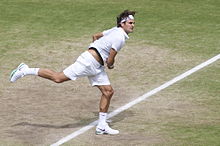
Roger Federer
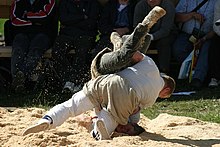
Swing
See also
![]()
Portal: Switzerland - Overview of existing articles on the topic "Switzerland
- List of famous Swiss people
- Landscapes with "Switzerland" in the name
Questions and Answers
Q: What is the official name of Switzerland?
A: The official name of Switzerland is Confoederatio Helvetica.
Q: How many languages are spoken in Switzerland?
A: There are four official languages in Switzerland: German, French, Italian, and Romansh.
Q: When did Switzerland become neutral?
A: Switzerland has been neutral since 1815.
Q: Is there an official capital city for Switzerland?
A: No, there is not an official capital city for Switzerland but Bern is used as though it was the capital.
Q: What is the largest city in Switzerland?
A: The largest city of Switzerland is Zürich.
Q: What countries border with Switzerland?
A: To the north of Switzerland is Germany; east of it are Austria and Liechtenstein; to the south of it is Italy; and to the west of it is France.
Search within the encyclopedia
